Rudy Rucker's Blog, page 50
May 29, 2011
"Turing Chronicles" excerpt: Bill/Joan showdown.
I haven't been in a condition to write any fresh blog posts this month, but I should be better soon. In the meantime, just to keep the blog alive, I'm posting an excerpt from my novel-in-progress, The Turing Chronicles, which features William Burroughs and Alan Turing in a relationship.
In the following passage, Burroughs describes a 1955 scene where he returns with Alan and their friend Judy Green to the room in the Bounty Bar in Mexico City where Bill shot his wife Joan Vollmer in 1951. He hopes to come to terms with Joan's ghost. Bill, Alan, and Judy are all "skuggers," that is telepthic, shape-shifting mutants hosting a parasitic slug-like being called a skug. Judy is an early electronic musician, who creates a kind of artificial sound she calls acousmatics.
The illos for this post are random images that have accumulated in my to-blog folder.
[Begin excerpt of draft for The Turing Chronicles.]

We were nearing the all-night market that we'd passed on the way to the graveyard. Alan trotted over to one of the butchers there and—how horrible—purchased a hundred-pound skinned calf, draping the creature across his shoulders. Uncut protein for Joan.
I'd asked the Bounty bartender for any old room. But—I could hear the unerring ping of synchronicity—he'd given us the very room in which I'd shot Joan in 1951.
The room had become a short-term spot for whores and johns. Where once the lodging had held books, rugs, and a circle of friends, it was now reduced to a bed, a chair, a light bulb, a glass by the sink. Alan threw the slaughtered veal calf onto the dirty floor. A church bell tolled midnight. I closed the door. The intense silence peculiar to Mexico engulfed us—a vibrating, soundless hum.

I spawned a skug off my stomach and laid it upon the veal calf. The bony flesh shuddered and took on life, forming itself into a featureless loaf. I laid Joan's finger atop the swollen, pulsing pillow—I was like a bishop installing a saint's bone.
Judy Green sang to the skug, running her odd voice up and down some archaic scale, and vibrating her skin to add dark, low overtones. Guided by the finger's DNA, and by my teeped hints, the skug morphed into a crude human form, tightened into something like a window-dresser's mannequin, then locked into a replica of Joan's final, spindly form. A golem.
I set to work on programming the thing's mind via teep, reconstructing Joan's personality from my memories. I remembered the early days—camping on Joan's vaguely oriental bed with coffee and benzedrine, chattering about decadence and nothingness, Joan alluring in her silks and bandannas. I thought of Joan catching a June bug outside our shack in Louisiana, and tying a thread to the bumbling bug's foot—Joan called it the beetle's hoof. She flew it in a circle around our heads. Even in Mexico City, Joan kept her slant humor, seeing the adventure in the squalor, making herself at ease on a pile of six mattresses, calling herself the princess and the pea. A phrase from Allen's memoriam poem popped into my mind. "She studied me with / clear eyes and downcast smile, her / face restored to a fine beauty." And now it was so.

Joan's body sat up and blinked, very jerky, very robotic. This wasn't going to work. But now I saw the glinting ultraviolet cuttlefish of Joan's ghost. She was dawdling at the fringes of visibility, twiddling her tentacles and flipping her hula-skirt fin, making up her mind. And now she dove into the skug.
Still sitting on the floor, the Joan-thing shuddered like a wind-riffled pond. She fixed me with her eyes and began talking, her voice languid and intermittent, like music down a windy street.
"I want to leave. I want to go to paradise. But I'm not done with you, Bill."
"I'm agonized by regret," I said. "I writhe abjectly. Go up to heaven, Joan. You deserve it. Forgive me and go."
"What about little Billy?" asked Joan, rising lithe to her feet. She seemed taller than I remembered. Reaching out, she laid a cool hand on my face.

Immediately I had a physical sense that I was carrying a large covered basket. I'd been carrying it in my arms for a long time. Our son Billy was in the basket. He was going to die.
"I'll help him!" I cried. "It won't happen that way." I stepped back, breaking Joan's hallucinatory contact.
"You won't save him," said Joan, bleakly mournful. "I know you." She looked around as if only now recognizing this as the spot where I'd shot her.
I stood frozen in place, awaiting her next move, more than ever wishing I hadn't set this in motion.

"Ooooo," said Joan, her voice purring up through an octave. "I know. It's time for our William Tell routine."
Without moving her arms or her shoulders, she poked her head out on a snaky tendril, scanning the room. Of course she spotted Judy Green's gun.
"No," said Judy, guessing what lay ahead. It was like we were playing out a script. Joan held out her hand. In thrall, Judy passed her the pistol. Turing sat goggling like a mute imbecile.
"The glass, Bill," said Joan, her voice low and firm.
I moved across the room like a fish in heavy water. I set the glass on my head.

A few paces away from me, Joan raised the pistol.
"Don't," I said, faint and husky. "Don't shoot me, Joan."
She fired. I flinched to the side. The bullet struck my temple. I slumped to the floor: deaf, blind, undead. I could still sense things via teep.
"It's over!" breathing Joan, with a fading lilt of summer in her voice.
Her ghost wriggled from her skugly flesh and fluttered in the air. Like a dragonfly now, not a cuttlefish. Flying around the borders of my teep, she shrank as if moving far away. Joan's spurned new body reverted to being a skug. It raised one end, as if sniffing the air, then humped along the floor and out the window.

Brain-scrambled as I was, I hallucinated that I humped my own body after Joan's skug. Fully into the invisible zone of the astral plane, I slithered out the window and—just for jolly—levitated myself fifty feet high in the air. See me fly?
La policia kicked in our rented room's door, inevitable as stink on shit. It was like a straight-on replay of 1951, but with me in a new role. As the victim, I lay naked on a marble slab with a spongy erection. Cops all around.
"We need acousmatics," said Judy. "I memorized the sounds of a race riot in Miami. I'll pump the replay from my skin, mixing in the shrieks of swine at the slaughterhouse. We'll raise Bill and rectify those policia pronto."
My head was splitting in unbearable pain. I retracted my limbs, blanking things out.
"Bill?" said Alan, leaning over me and shaking me. "Bill?"
We were still in the room where I'd been shot. I sat up and spit the bullet from my mouth. The sun was high.

"What a burn," I said. "Let's split this scene."
"Agents everywhere," said Judy, leaning out the open window. "Like flies on meat. We need more acousmatics." She emitted a fresh torrent of noise. It was a collage of every sound I'd ever heard in my life—thrown into a rock-tumbler.
The sky went pale green. Hailstones fell past, big as hens' eggs, shattering on the street. Elephants trumpeted frantic at the drone of an approaching twister. The street-side wall rocked twice and exploded out. Turing and I slid helpless across the floor, pissing our pants. Cars flew through the air with clown-cops behind the wheels. A striped circus tent swept upwards, drawing me into a whirling shattered midway of bleachers and shooting galleries, of sugar skulls and Socco Chico queens…
Poised at the virtual tent-peak of the vortex was Joan, far and wee, the bride on the funeral cake, luminous white, bidding farewell, giving me the finger. Behind her glowed the divine light of a heavenly Missouri sunset.
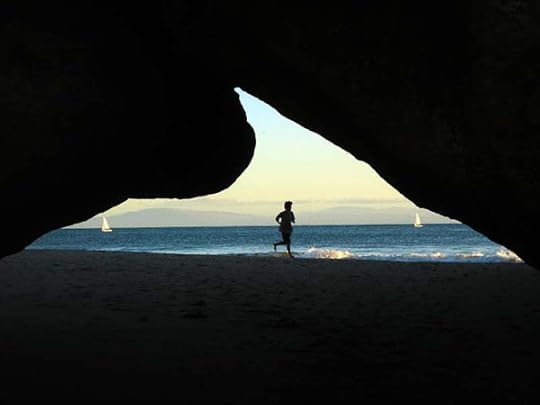
Cut. I was still in that room we'd rented, lying on the floor in a clotted crust of blood. I'd been here all night, reflexively regrowing my brain. The sunlight lay like pig iron on the ground. The police had dispersed—if they'd ever been there at all.
[End excerpt of draft forThe Turing Chronicles]
May 16, 2011
Four New Books
I have four books coming up.

(1) I just published a new edition of my art book, Better Worlds, on Lulu. It has 79 color paintings now, and sells for $29 paperback or $5 as a PDF.
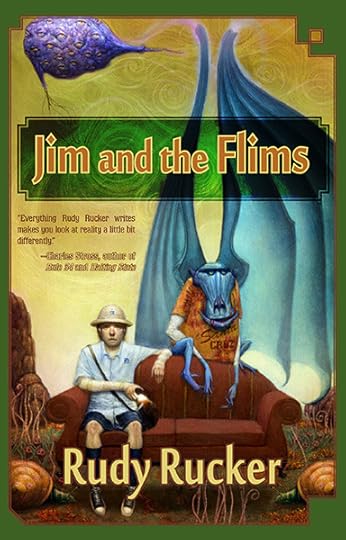
(2) Jim and the Flims, my fantastic novel of Santa Cruz and the afterworld will appear from Night Shade Books in June, 2011. See my JIM AND THE FLIMS page for more info.
I'll be giving a reading from Jim and the Flims at the Capitola Book Café on June 4, at 6:30 pm, sharing the podium with Kim Stanley Robinson. And I'll be reading at Borderlands Books on Valencia St. in San Francisco on Sunday, Jun 10, at 3 pm.
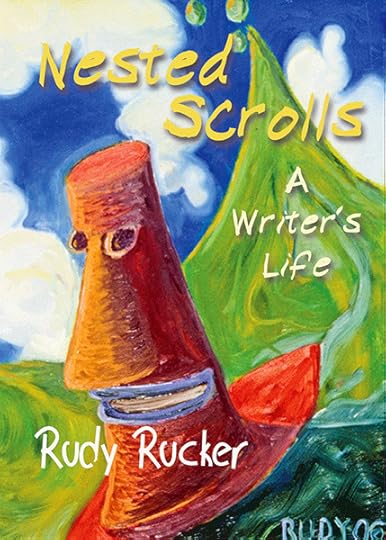
(3a) My autobiography Nested Scrolls is also coming out, first in a limited edition from PS Publishing in July, 2011.

(3b) And a second edition of Nested Scrolls will appear in a hardcover from Tor Books in December, 2011. See my NESTED SCROLLS page for more info.
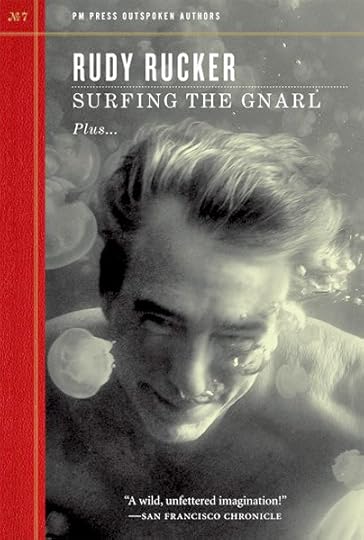
(4) Last of all, my small anthology Surfing the Gnarl will appear in the Outspoken Authors series from PM Press in January, 2012.
May 15, 2011
File Drawer
I've lost my rhythm of blogging, so today I'm trying to get started again. I'll just be posting a variety of stray photos in my files with my comments.

Rudy, Jr., took my picture in a clown wig the other day.

I've been to the San Jose airport a couple of times. They have a fairly awesome robot/sculpture at the arrivals gate in terminal A.
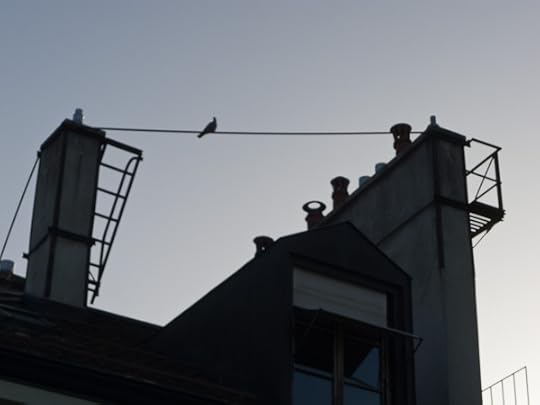
A rooftop in Geneva. I love rooftops.
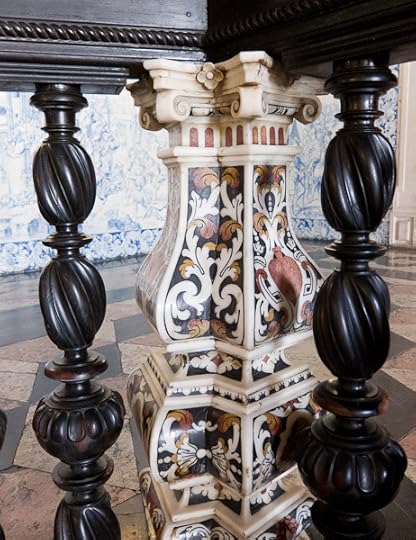
A stone leg in Lisbon, with inlaid tiling.
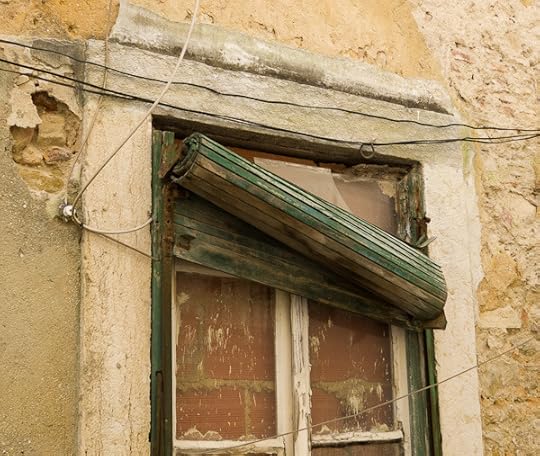
A beat old roll-up shade in Lisbon. I like how funky Lisbon is.
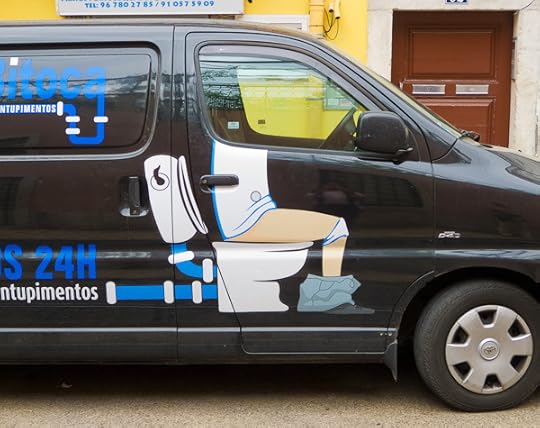
A plumber's truck in Lisbon. When the driver's in the van, the drawing on the door represents his body.

A pipe draining into the flume at Lexington Reservoir in Los Gatos. It's still overflowing a little bit.

Moray eels at the Monterey Bay Aquarium. I went there with my big brother Embry. It was jam-packed as usual.

A fence in Berkeley. I'm always a little amazed at how well perspective takes care of itself.

Yet another picture of the Mittens in Monument Valley this summer.

Some laundry in Lisbon. The laundry adds a lot of color to the narrow streets.
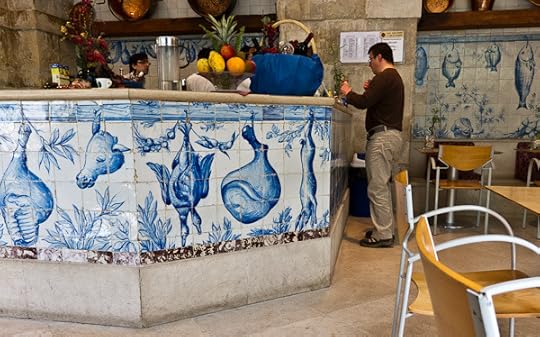
The food bar at the Museum of Tiles in Lisbon. This is a great place.
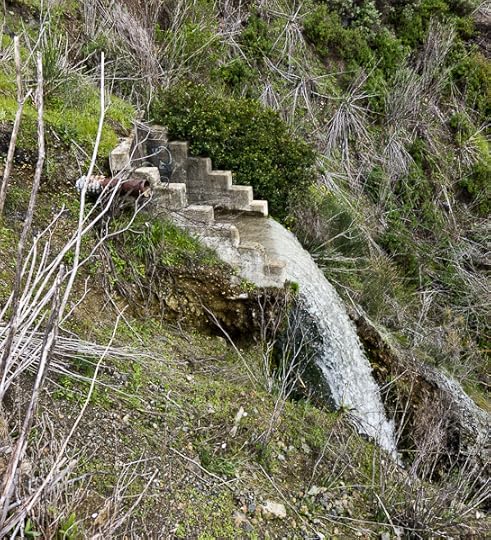
A waterfall near the Lexington Reservoir near Los Gatos. I like the contrast between the analog flow of the water and the digital steps of the concrete walls of the fall.
May 3, 2011
Munich 3: Three Heavy Topics
I'm running out of Munich pictures, so you'll see some Lisbon pictures mixed in with today's post, which touches on three heavy or philosophical topics.

[Creepy cat in Lisbon graveyard.]
(1) The Germans are, as one would expect, very thorough, and very attentive to rules. One doesn't cross an empty street if the pedestrian "Walk" light isn't on. If I show my ID to a museum ticket-seller to get the senior rate, she's actually going to read the month, day and year of my birthday. When the woman in the grocery-store hands me my bag of food, she admonishes me to hold both handles of the bag lest I spill my purchases. Another woman advised me about how to heat up a Munich-style white hotdog without (auugh!) bursting it. But there's a cheerful, agreeable quality to all this, a kind of "We're playing this game together," attitude.
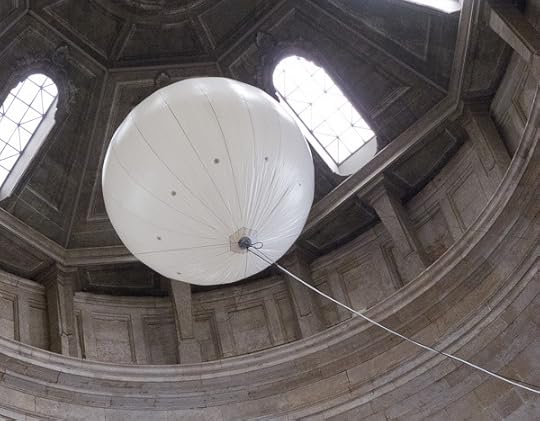
[Balloon used for lamp fixture in Lisbon church.]
Walking around, I keep admiring how attractive, tidy and cultured the Germans are. In the course of my life, I've lived in Germany for about three years, and I'm comfortable here. But, having been away for so long now, I'm also sensitive to the sinister side of Germany—I'm referring of course to the Nazis.
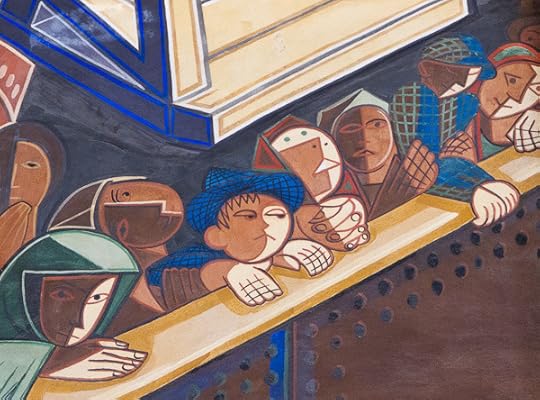
All three of my uncles were officers in the German army—they had no choice but to enlist. My uncle Rudolf von Bitter died on the Russian front, the other two were captured and served time in Russian and English prison camps. My grandfather Rudolf von Bitter is said to have helped the underground resistance against the Nazis. The family sent my mother to America in 1937 so that at least one of them would survive the coming war.
I'm not blindly on the Germans' side— we even have a few Jewish ancestors far up in our German family tree, and if the Third Reich had gone on indefinitely, my relatives might have ended up in the death camps. Even so, it's not reasonable to assume that typical Germans are racists and heartless killers—any more than it's reasonable to think the same about all Americans in the wake of Hiroshima, say, or My Lai.
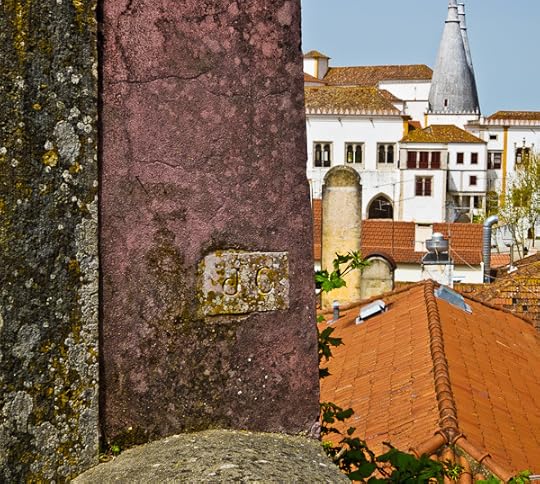
[A nice patch of wall in Sintra, Portugal.]
But still. Why did the Germans have to act so terribly in the Second World War? It's undeniable that the Nazis had huge popular support. I found myself wishing that it were somehow possible to change history so that the horror had never happened. I was wishing that my race could be cleared of blood-guilt.
I talked this over with my cousin Rudolf. He, of course, has thought about these questions quite a bit. I'll condense and paraphrase his remarks.
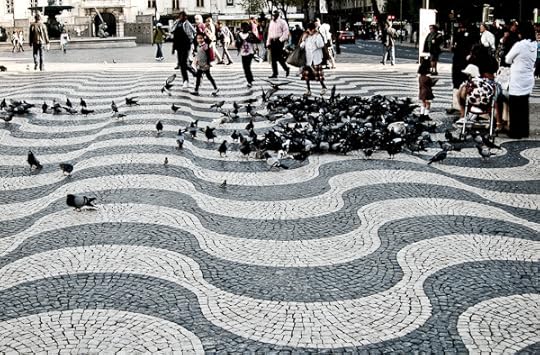
[Tiled Rossio Square in Lisbon.]
"If you are accused of a crime, or if the group you belong to is accused, it's better to begin by admitting your guilt. Denial leads nowhere. Hitler is part of the German character. And, yes, we have our fine culture as well, for instance, Goethe. But to imagine that we could somehow keep the Goethe and get rid of the Hitler is a lie. G and H. Next to each other in the alphabet. I also think of Goethe's story, Der Zauberlehrling (The Sorcerer's Apprentice); a meditation on the dark side of intellectual and technological power."
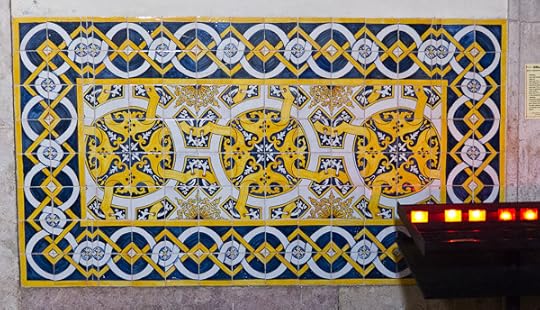
[Chuch tile with holy candles in Lisbon.]
No real answer.
(2) Looking for things to do that didn't involve walking, I went to a concert in a former imperial church, a sequence of seven Haydn sonatas based on Jesus's "Seven Last Words," these being the seven direct quotes of Him that appear in the Gosper of Saint Luke.
My favorite of these is where the Good Thief says, "Lord, remember me when you come into your kingdom." And Jesus seems to agree with that, and says, "Verily I say unto you, today you shall be with me in paradise."
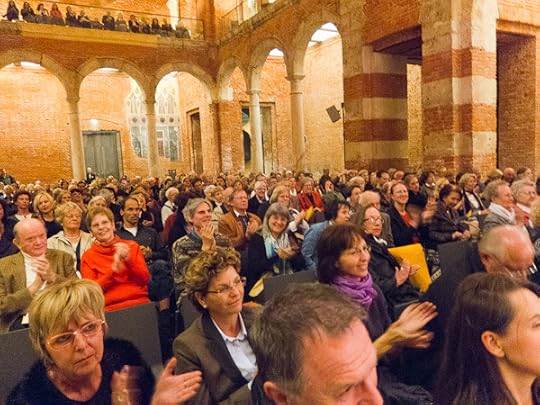
[German concert crowd.]
I once had an interesting discussion of this passage with my old science-writer mentor, Martin Gardner. Some religious sects have take the exchange between Jesus and the Good Thief to mean that your soul isn't in fact immortal on its own, but is, rather, a pattern of information that God stores in His memory so that He can resurrect you. Sometimes the word "soul sleep" is associated with this notion, but if you try Googling or looking in Wikipedia, you find a bewildering gamut of variations on this (heretical by some lights) doctrine.
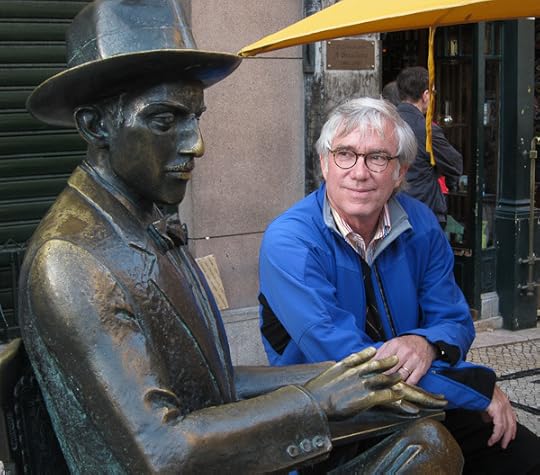
[Me in Lisbon with a statue of poet Fernando Pessoa]
Keeping it simple, to me the Thief/Jesus exchange suggests that the soul can in fact be represented as software, that is, as a pattern of information that God (or a sufficiently large computer memory) can store.
"Remember me!" What a great request.

(3) On my last day, I rode Rudolf's bike to the Neue Pinakothek, a Munich museum with 19th and early 20th century art. The Neue Pinakothek had a nice Ferdinand Hodler, shown above, and a couple of good van Goghs. Studying his works in awe, I started thinking it might be fun to try some paintings in which I use enough extra paint to build up an impasto relief of brush strokes.
I always wonder why van Gogh killed himself. Wouldn't you be happy if you could paint that well? I guess he was out there alone on some kind of unbearable edge. It's hard to visualize just how crazy some artists are. It occurs to me to do an SF move on van Gogh—that is, to imagine a future kind of art with its own kind of crazy artist. The notion of future art forms fasinates me.
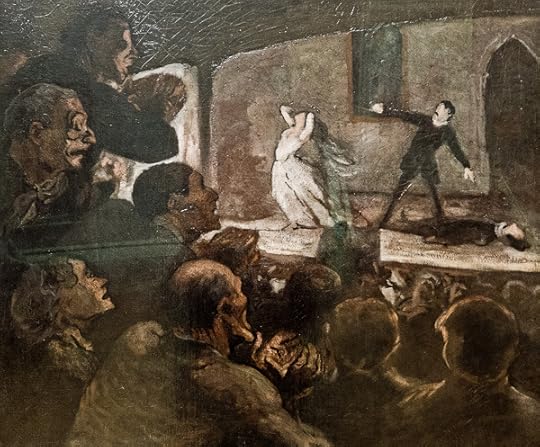
I also noticed an Honore Daumier painting of some excited folks goggling at an onstage drama. Antonio Damasio argues in his book The Feeling of What Happens, that the essence of consciousness is to have, get this, a mental image oneself watching one's life unfold. At level 1, we simply are em embedded in life, we're like the actors on the stage. At level 2, we can stand aside a bit, and see life as a spectacle. At level 3, which is where Damasio says consciousness kicks in, we are aware of ourselves as detached observers of life's passing scene. You're looking at the Daumier painting of yourself. As I discuss in my tome, The Lifebox, the Seashell and the Soul, (see the online version of the relevant passage here), all of Damasio's levels can, at least in principle, be modeled in computer software.

[Egyptian style rings at Gold and Silver Market in the Scwabing district of Munich. Like language tokens.]
After the museum, I sat in their very pleasant outdoor cafe for a long time, eating while reading Raymond Chandler, The Big Sleep, a book I'd dug up at Rudolf's apartment—I think his daughter had it assigned for her English class. After two and a half weeks, I was kind of done with doing something touristic every minute. I was edging towards the next level—of simply living abroad.
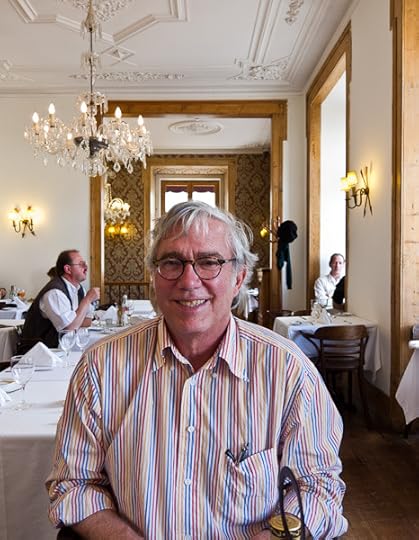
It had been awhile since I'd read Chandler, and I'd forgotten just how wonderful a writer he is. His use of language is exquisite, as in his thumbnail sketches of his characters' personalities. And his dialog is wonderful, rife with odd-ball 1930s slang—probably nobody ever really talked that way, but the patois makes for a wonderful seamless level of discourse that holds his worlds together.
From Farewell My Lovely: "I felt like an amputed leg." "…my bank account was still trying to crawl under a duck…"
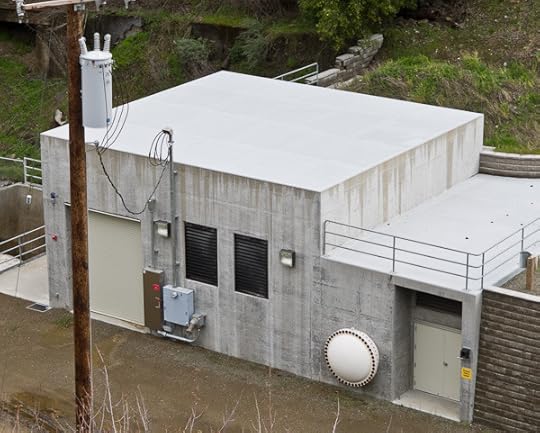
[Water works building near dam in Los Gatos, California]
Chandler's slang reminds of the way that I often make up a standard slang for my SFictional worlds. I've learned that it works best if the words in this alternate language are short, easily spelled, and easy to say, like the well-polished words in actual human speech. Sometimes one can repurpose an existing word, but it's often better to invent a previously unused word—if you scratch around a bit, you'll find there's really quite a few good and usable syllables that don't happen to be standard English words. In picking a made-up word, you have to be keenly aware of the word's associations, that is, if it sounds a bit like some real word.
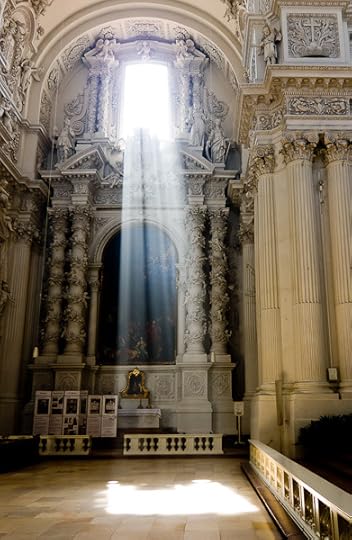
[Theatiner church in Munich.]
Anyway, my time in Munich finally ran out and, next step, next step, next step, I called a taxi to pick me up at 5 am to take me to the station to catch a suburban train to the airport, etc. And now polishing these notes, I'm looking across my desk at our cozy backyard.
Thank you, Cosmos! It was a good trip.
May 1, 2011
Munich 2: Culture Vulturing
I went by a favorite little museum of mine, Villa Stuck, the Jugendstil home of this odd turn of the century artist, Franz Stuck.

Stuck was a handsome, sociable man. He seems to have worked his way up, making a career as an artist and architect, marrying a possibly wealthy American woman, being made a noble and becoming "von Stuck," and teaching art for many years at the Munich art academy, with students such as Paul Klee and Fritz Albers.
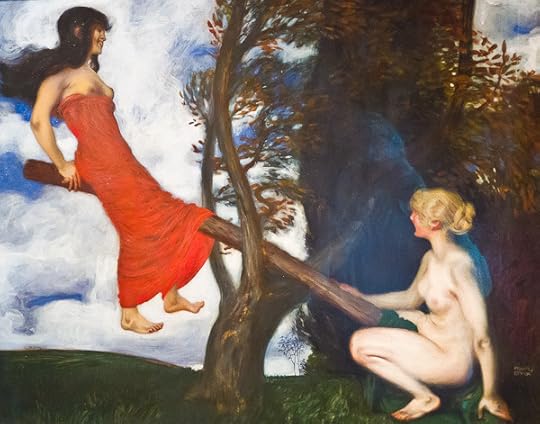
Stuck isn't really the most talented painter—his images are almost like outsider art, filled with idiosyncratic mythological references and slavering eroticism. His 1898 painting, "Die Wippe" ("The Seesaw") all but shows a pair of women, a blonde and a brunette, sharing a dildo, with one of the women leering and the other blushing and turning her head.

But Stuck was something more than a painter—he was an impresario, perhaps a bit like a Pop artist. He made elaborate, architectural gilded frames for his paintings—particularly for his greatest hit, Die Suende (or "Sin"), which he copied and resold a number of times over. And he used the modernist expedient of photographing models and using those images to lay out his paintings. I like Stuck more than Sylvia does—of his work she once remarked, "Did this guy ever go outside and look at anything real?"
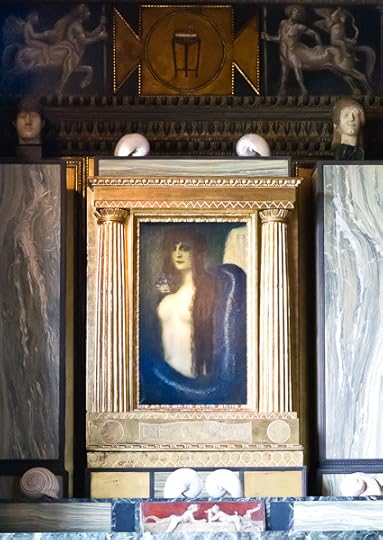
It's not just the art in Villa Stuck, it's the building itself, with every surface completely decorated. And upstairs in his studio is a copy of Die Suende atop a huge altar with polished nautilus shells on it. I love artists. Like so many of the buildings in Munich, Villa Stuck had to be restored after World War II.
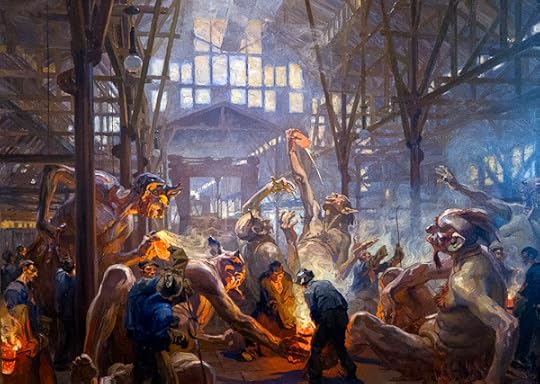
[Kley's "The Krupp Works Devils" Click to see larger image.]
The Villa Stuck had an interesting temporary exhibition of works by Heinrich Kley. There was one large and amazing 1913 painting of the Krupp steel mill, Die Krupp'schen Teufel ("The Krupp Works Devils"), with huge demons commingling with the workers—the demons representing, I think, the elemental forces of nature involved in smelting—as opposed to the evils of arms-manufacture. Kley did this work on commission from the Krupp company shortly before World War One.

[Kley's "Dancing School #1" Click to see larger image.]
In later years, Kley became a regular cartoonist for the legendary journal Simplicissimus, and he did a number of cartoons of animals behaving like people. In 1912, he created a classic comic strip called "Die Tanzschule" ("Dancing School"), in which an Elephant and a Crocodile are learning to do ballet.
Studying Kley's "Die Tanzschule" on the wall actually made me laugh out loud. The elephant and the crocodile aren't merely playful, they want to learn to dance, they're transported by their motions, and the crocodile howls and sobs with the elephant steps on her tail.
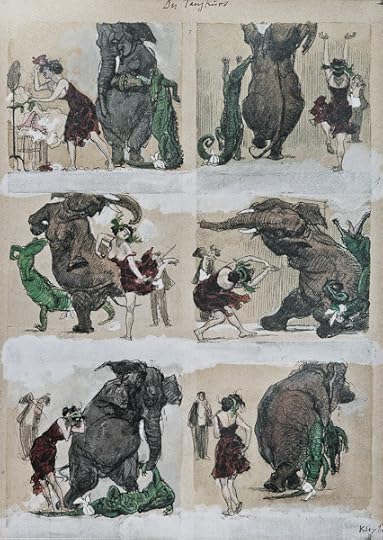
[Kley's "Dancing School #2" Click to see larger image.]
In 1940 this strip served as an inspiration for the "Dance of the Hours," scene in the Disney animated film Fantasia. In Villa Stuck, they had a few drawings from the Disney film to drive home this point .
But the crocodiles in the Disney seem witless, each with the same fixed "devilish" smile in the corners of their mouths. Disney vs. Heinrich Kley is a bit like the low humor of Douglas Adams vs. the heart-piercing wit of the still-insufficiently-recognized grandmaster Robert Sheckley.
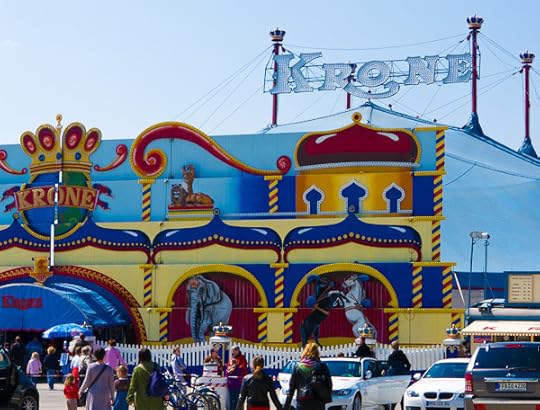
Another thing I did in Munich was go to the Krone Circus.
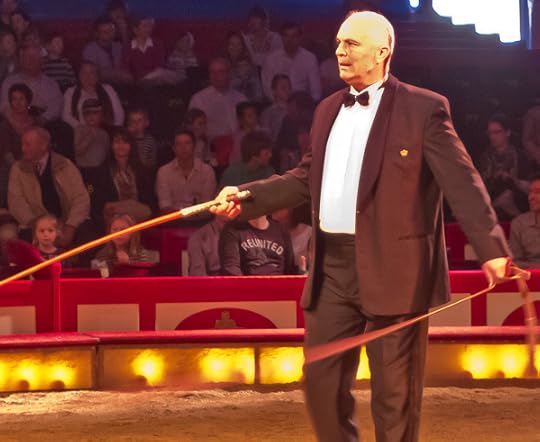
I like circuses anyway, but a European circus seems especially cool, perhaps everyone there is a European local—you pretty much never see another American tourist at the circus.
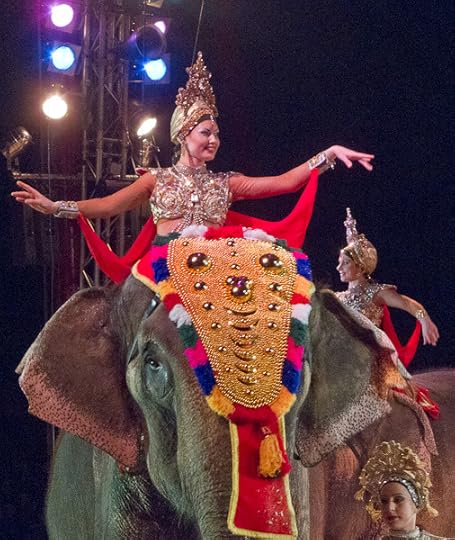
It was a one-ring circus with elephants, a pair of clowns, and some trapeze artists.
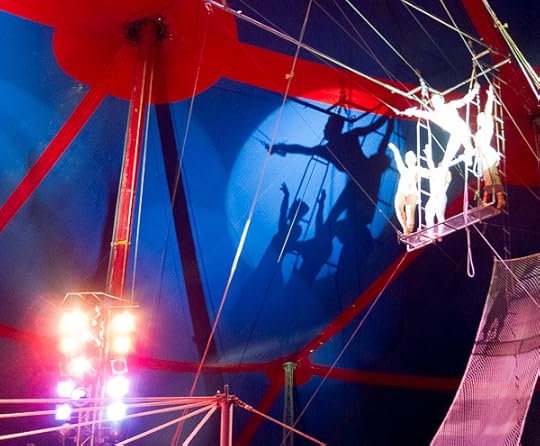
It reminded me of a time about thirteen years ago, when I had a sabbatical, and Sylvia and I bummed around Europe for over five weeks—and we went to this little circus in Vienna, and I had a kind of revelation when I came out. Here's the passage:
Sunday afternoon, the 27th of September, 1998, there was a strange moment — S and I went to the Circus Roncalli at 3 PM, it was lovely, so full of color and laughter and love. And then we came outside and there was a chill in the air, and some low gray clouds — though still with blue showing through — and some of the leaves on the tree were yellow and it was like all of a sudden it was Fall, and it had come perhaps gradually and we'd been too busy playing to notice, it had been Summer when we left home, but now we'd stayed away so long that it was Fall, us off in a distant city, a feeling of having stayed away longer than I'd realized, and a feeling, too, that, in the great "year" of my life it's Fall. It turned to Fall while we were at the Circus.

I received no revelation this time, although I did get two or three good photos.
One more outing I managed was to see the München Volkstheater production of the Berthold Brecht and Kurt Weil musical, Der Dreigroschen Oper. (Three-penny Opera). It was cool to be in the huge crowds at the concert, the circus and the play. I had trouble understanding the rapid-fire dialog at the musical, but they had a seven-piece live band, and an amazing rendition of "Mackie Messer," a song from the play that we know as the pop standard "Mack the Knife"

[ The "Static Man" in Lisbon. Holds Guiness record for motionlessness. Somehow he has a hidden harness that suspends him in air from a cane sticking up from a platform.]
The actor singing "Mackie Messer," really tore it up. He was sleazy, unshaven, in a powder blue suit with no tie—like an on-the-skids lounge singer, but German as well. I'd almost forgotten this side of the Germans, that is, the expressionist, Grimm-brothers, Cabinet-of-Doctor-Caligari, freak-show, Scorpions heavy-metal aspect.

I left both the circus and the musical before they were over. I was mainly thinking about getting back to cousin Rudolf's apartment and lying on the couch. Or riding the tram and looking at people on the street. I've noticed this before—when I go out to shows alone, I find it hard to sit through the whole thing. It's not as much fun without someone to share your enjoyment. I recall one of my friends telling me that, after his wife left him, he was unable to go sit through an entire movie in a theater. Perhaps we're such creatures of the herd that when we're alone, we feel impelled to range about in the hope of striking up a conversation.
April 30, 2011
Munich 1: My Cousin Rudolf
Munich is such a beautiful city. Lots of buildings were bombed in the war, but the Germans have restored it out the wazoo. In spots, Munich is almost like a theme park, although even the new things are build from solid metal and stone. Things are solid and well-proportioned, with lots of trees.

Since I was alone in Munich for much of time time, I wrote more notes and took more pix than in the other spots, so I'll break this material into several posts, with the tense somewhat randomly oscillating between present and past—which is, I suppose, vaguely appropriate.
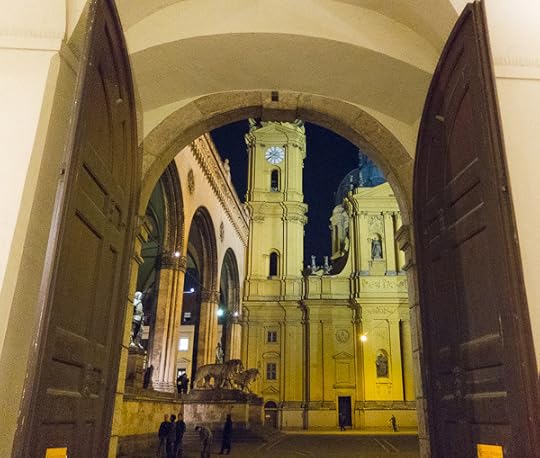
The big cathedral downtown was pretty much reduced to rubble, but the Germans put it back the way it used to be.
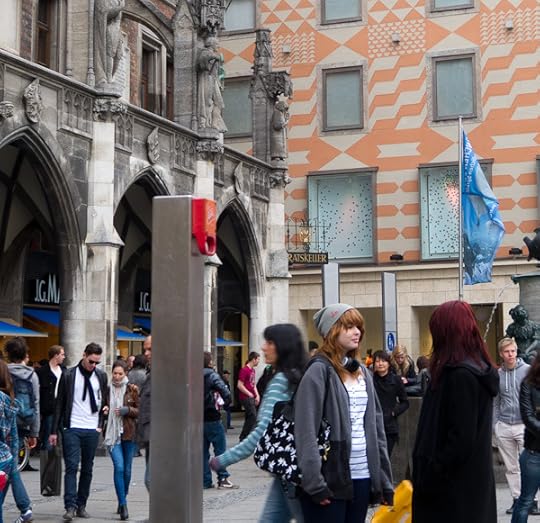
The Altes Rathaus (old town hall) got destroyed, and was rebuilt in a fairly ugly way, but there's a gothic-looking Neue Rathaus (new town hall) from 1908 (shown on the left above) that's pretty cool, although my cousin Rudolf says it's kitsch in that it imitates being medieval Gothic.
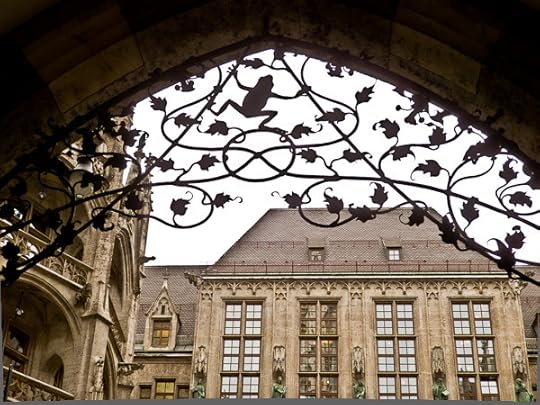
The Altes Rathaus has some wonderful wrought iron, I liked the fairytale-border-illo quality of that frog shown above.

And there's some great old Jugendstil (that is, German Art Nouveau,) buildings as well.

The apartment block where my cousin Rudolf lives with his family on the fourth floor is Jugendstil, and there's a cute carved bear on newel post at the bottom of the well-waxed flights of walk-up stairs. Very 1910.
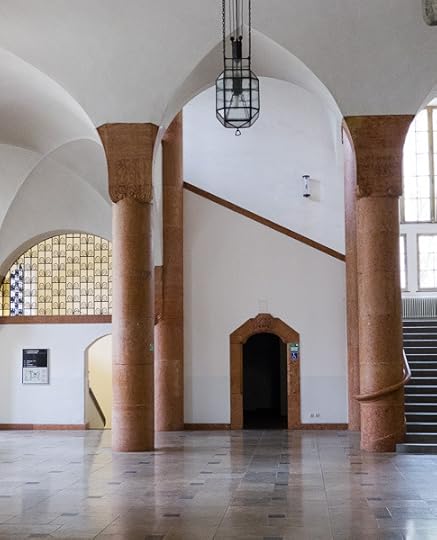
Some amazing buildings in Munich are relatively uncelebrated like, for instance, the Jugendstil lecture hall at the Leopold Maxmillian University. And, like I say, there's a bunch of amazing Jugendstil houses around, too. I love that stuff. Will we ever find our way back to the wonders of heavily ornamented architecture? Or are we stuck with cheap-ass blank walls for the rest of time?
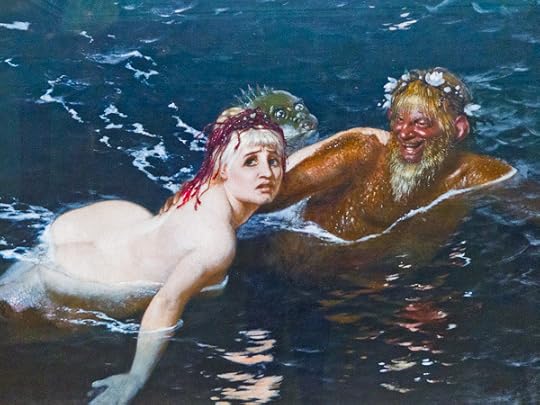
I'm half-German—my mother was the sister of my Cousin Rudolf's father. Not that they bore any resemblance to this cartoony old painting of a mermaid and merman.
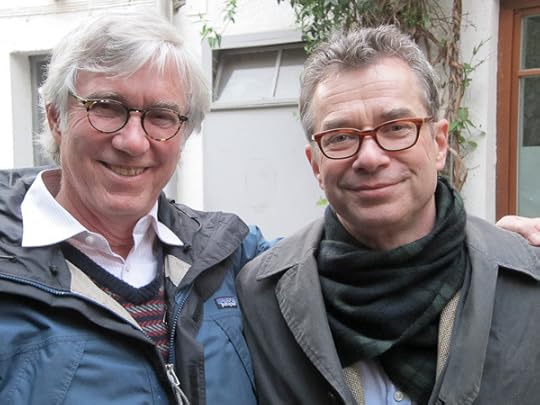
My cousin Rudolf von Bitter is a smart guy. He's an author in his own right, with quite a few books—this link searches German Amazon, with a couple of mine sneaking in. He organizes author videos for the Bavarian TV channel. He also has a LiteraVideo webpage with some quirky authorial videos that he's made on his own.
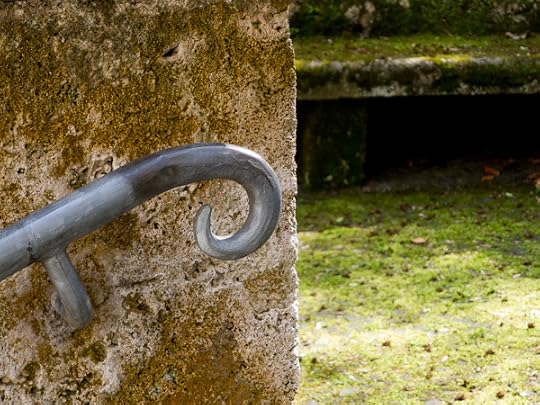
He drives a beat-up old-style VW beetle, he sought out one made in Mexico for the authentic old-school look. I called it a dreckige Käfer (dirty beetle.) His manner of talking shares a quality of Bruce Sterling's—you can never quite tell when he's being sarcastic. We were making dinner plans, and he exclaimed, "Schweinebraten um sechs!" (Roast pork at six o'clock!) I kind of thought he was mocking the eating habits of the average German, but that night he did in fact order Schweinebraten, albeit at seven. He does it, but he mocks it at the same time.
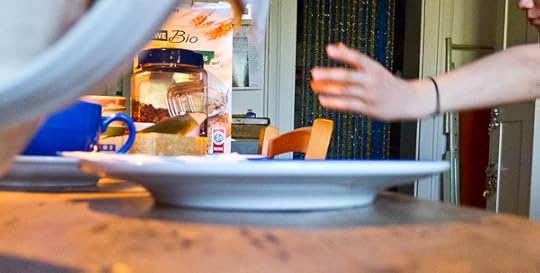
It was good sitting with Rudolf's family, enjoying the glow of their home, and listening to them, sharing food.
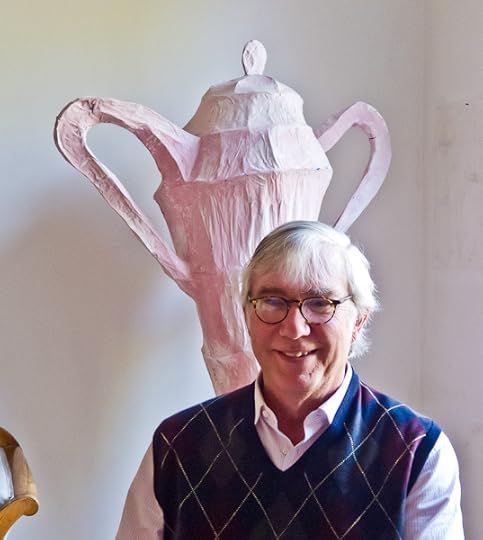
A restaurant where we ate together had a life-sized bronze sculpture of a pig outside. I posed with it, and a drunk Bavarian smoking outside the restaurant said to me, "Schweine gehören zusammen." ("Pigs belong together.") But I'm not going to run the picture of me with the bronze pig. Instead here I am with one of Christina's sculptures.
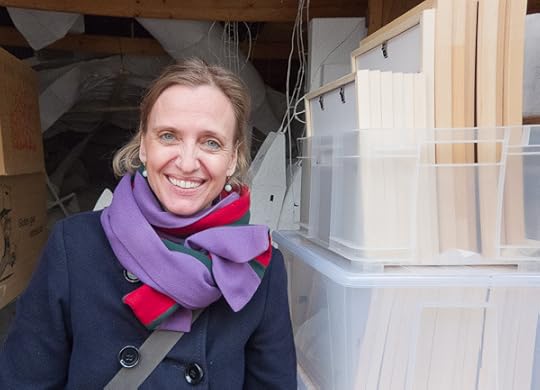
I'm referring to Rudolf's wife Christina von Bitter . She's a wonderful artist—she makes sculptures of whimsical large constructions from wire, paper and paste, some pink, but mostly white.
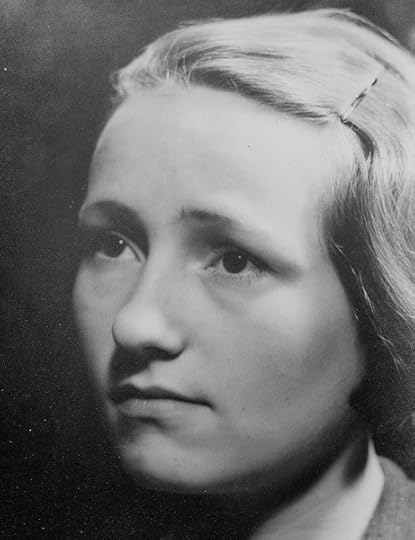
[My mother in 1936.]
Rudolf's two children are very well-bred and pleasant. His 17-year-old daughter looks a little like my mother looks in a photo taken when she was about 20. There's a certain shape of nose that my mother and I and Cousin Rudolf have, the von Bitter nose, and I see a little of that in Rudolf's daughter. And there's some similarity in their brows. How touching to come back to Germany and find an echo of Mom. It's touching and a bit uncanny.
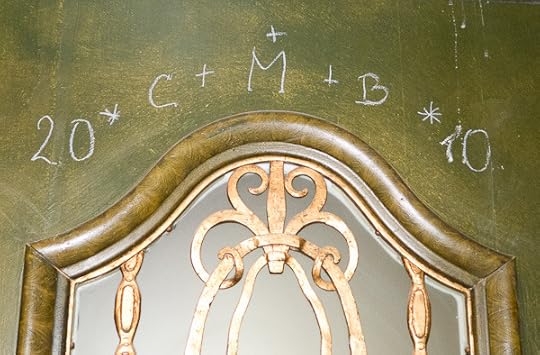
One of Rudolf's neighbors puts a special New Year's inscription in chalk on their door every year, I saw a few more of these around town. They have to do with Epiphany, the Feast of the Kings. The letters stand for Caspar, Melchior, and Balthazar—the names of the kings.
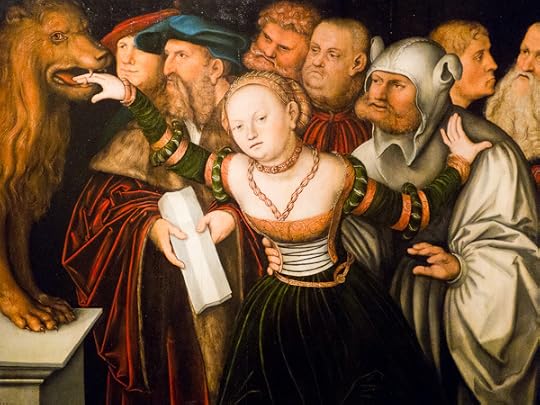
[Hans Cranach the Elder, "The Mouth of Truth" (If you tell a lie, it bites your hand)]
Unlike me, cousin Rudolf has actually read the whole of The Phenomenology of the Mind by our common great-great-great-grandfather Georg Hegel. He advised me on a tactic for finally plowing through it. "Read it like a novel. Even better, follow the advice of the Hegel scholar Ernst Bloch, and read the Phenomenology in parallel with Goethe's Faust."
By the way, here's a zoomable PDF of our shared family tree, which was made up by our common uncle, also a Rudolf von Bitter, who died young in WWII. You read it in reverse, that is, Uncle Rudolf is at the top, and his ancestors are futher down. My name is Rudolf von Bitter Rucker, you understand. So cousin Rudolf and I would be one step furthere above the top of our uncle's family tree. You can find Hegel down there among the ancestors.
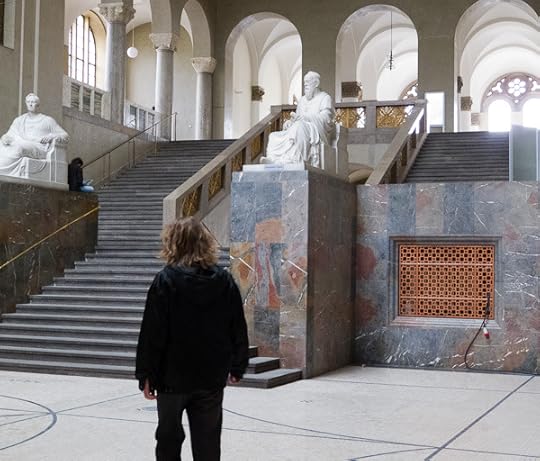
Rudolf and his wife Christina and their two children were about to drive to Italy for a family vacation—it's an eight to ten hour drive. They like to listen to an audio books on CDs during these long drives to pass the time. Christina had considered getting Thomas Mann's The Magic Mountain, but instead had gotten an Agatha Christie novel (in German). And Rudolf exclaims, "No, I have gotten CDs of Franz Kafka's Der Prozess. It's really very funny."
Although I was in fact sympathetic to Rudolf's proposal, at the same time it's incongruity cracked me up, it was like something a Woody Allen character would do—"Uh, yeah, I like to play a tape of Kafka's The Trial when I'm a long trip with my family." Rudolf is truly my cousin.

I didn't make it to the famous Hofbrau Haus this time, although I did swing by an outdoor offshoot of the Hofbrau near a Chinese Tower in the park. A brass band pumps oompah music from two stories up in the tower, and you can buy a soft pretzel the size of a baseball catcher's face protector.
Munich is Beer City, and it took some effort on my part to maintain a sane frame of mind. I actually saw a group of ten guys pedaling a bar down the street, a man-powered trolley, complete with a giant wooden keg of beer, big steins on the bar-top, and rowdy singing.
I had one non-alcoholic Lowenbrau in a beer garden, just for old times' sake, but that was enough. For the rest of the time, I stuck to a pleasant drink that Christina von Bitter steered me to: Apfelshorle, which is apple juice with sparkling water mixed in.
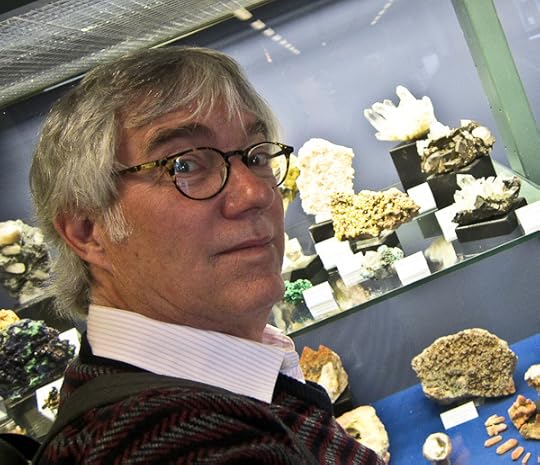
I had a pleasant flashback, walking into a museum of crystals run by the geology group at the local university. When we were living in Heidelberg from 1978-1980, there were some displays like that, and I'd look at them while working on an early draft of Infinity and the Mind, my nonfiction book about infinity, and at the same time writing White Light, my novel about a guy who climbs to higher of levels of infinity in the afterworld. Each endeavor was feeding the other. And those crystals came to seem like symbols to me, and I dreamed about them. Here's a quote about this from my forthcoming memoir, Nested Scrolls: The Autobiography of Rudolf von Bitter Rucker.
I got into a very pleasant and exalted mental state during this period of time. I remember having a magical dream in which I was scrambling up the ridge of a mountain. The stone underfoot was slippery pieces of shale, and among the stones I was finding wonderful polyhedral crystals the size of chestnuts or hedgehogs. Even within the dream, I knew that these treasures represented my wonderful new ideas.

I liked seeing German words written out everywhere, I might smile at odd German surnames I spot, such as "Pfnür," which sounds a bit like my SF word, "fnoor". It's great hearing German spoken aloud. My Muttersprache, the mother tongue. Everything sounds somewhat funny to me in German. At one point I heard a woman complaining about an acquaintance. "Die blöde Kuh! Sie ruft mich ewig an." ("The stupid cow. She's always phoning me.") Love it.
I'd almost forgotten that I can speak German, but the skill comes back quickly. It's like remembering you can ride a bicycle. One thing I always need to remember is that I have to push the accent so hard that, from the inside, it feels like I'm straining and overdoing it. But if I don't make that extra effort, nobody can understand me. Certainly the locals treat me better if I try. They think it's cute to hear an American talk half-decent German. Like seeing a dog walk on his hind legs.
The working-class locals—the echt Bavarians—have a cozy way of rolling their R's. But my cousin Rudolf and his family speak the standard, less-accented German, the so-called hoch Deutsch.
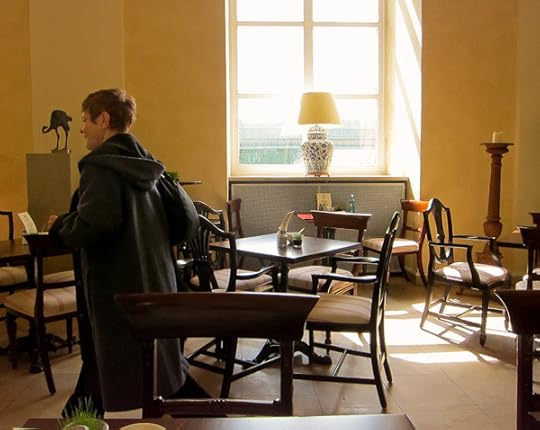
After Rudolf and his family left for their trip, I was my own for a few days, into my own head, which was fun, although at times a little lonely. I was definitely slowing down. Like a clock winding down. My legs were beyond tired after two weeks of vacationing. So I spend a lot of time sitting down in cafes.
In the mornings I lie on Rudolf's couch for awhile. When I'm motionless, it feels so good that it's hard to get up. Sitting with my legs crossed is an active sensual pleasure. I'm at a point where every day I want to walk a little less. So when I go out, I sometimes ride Rudolf's bicycle.

But it's good to get out. I saw five or six guys surfing on a standing wave where a piped surge of water flows out into a park meadow, an artificial stream called the Ice Canal. It's next to a bridge, and a big crowd was watching. Each guy would manage a minute or two on the wobbly wave, then eat it and get swept downstream. Surf München!

I feel like I'm having an extra inning of vacation here, a bonus round. Listening to an ensemble of classical musicians on the street, complete with grand piano. I start thinking about my life, and again about the Nested Scrolls autobiography I wrote, and about how much better things have turned out for me than I'd ever hoped.
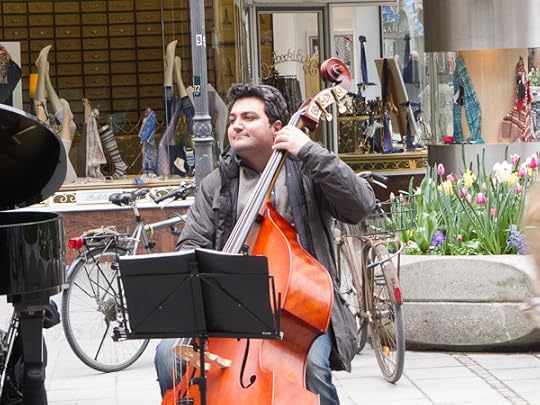
The sweet music fills my throat.
April 27, 2011
Revisiting Geneva
It was intensely nostalgic to return to Geneva. I first visited Sylvia at her parents' apartment there in 1964, the summer after my freshman year at Swarthmore. And we were married at the American Episcopal Church in Geneva in June, 1967.
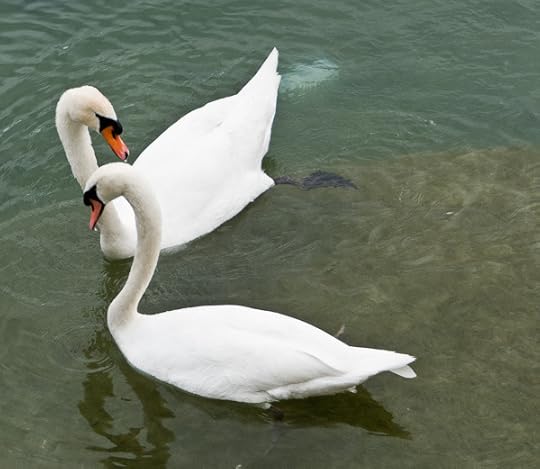
Sylvia's father Arpad worked at a branch of the United Nations called WIPO, for the World Intellectual Property Organization, and eventually he became the Director-General. Up until 2005, Sylvia and I visited Geneva once or sometimes twice a year—call it forty trips for me. And we always brought the kids along. We were were in Geneva with our children as newborns, as toddlers, as teens, as twenty-year-olds—over and over, year after year.

Sometimes I'd split off from the family and spend a few hours wandering the downtown alone. The biggest sight is, of course, the famous fountain in the lake, the jet d'eau. I remember working on some of my novels in Geneva—for instance I got the idea for the floating "Umpteen Seas" of The Hollow Earth by imagining Lake Geneva lifting up to hang suspended in the air, a giant, jiggling glob.

This time around, Sylvia and I stayed, for the first time ever, in a Geneva hotel. We found a fairly inexpensive two-star hotel called La Bel' Espérance, run by, of all people, the Salvation Army. Not that the hotel guests were street people, they were low-end business types and frugal tourists like ourselves. The nice thing about the hotel is that it's on a quiet side-street in the heart of the cute medieval part of Geneva called the Vielle Ville, not far from a nice old cafe-lined plaza called the Bourg de Four.

One thing that kept striking me about Geneva was how many things have remained unchanged over the forty years I've been going there. Although it seems as if they're continually doing construction on the city—a lot of this work involved retrofitting or strengthening or restoring or refurbishing the same stuff that's always been there. It's worth noting that there's not much graffiti in Geneva. Although I'd gotten to enjoy the wall decorations in Lisbon, it was kind of relaxing to see the unblemished gray and beige walls of Genève.

It being April, the weather fluctuated between rain and sun. Lush chestnut trees line the old city wall around the Vielle Ville. After so many visits, I know the streets of Geneva very well—better, really, than I'd expected. At every turn, new memories came floating up.

Our daughter Isabel and her husband Gus turned up in Geneva the same day as us, and we had a lot of fun walking around with them, showing them some of our favorite spots. We four had a nice lunch at a cafe that Sylvia and I have always loved, it's in an 1890s pavilion in a park below the old city wall, the park also holds some buildings of the University of Geneva.
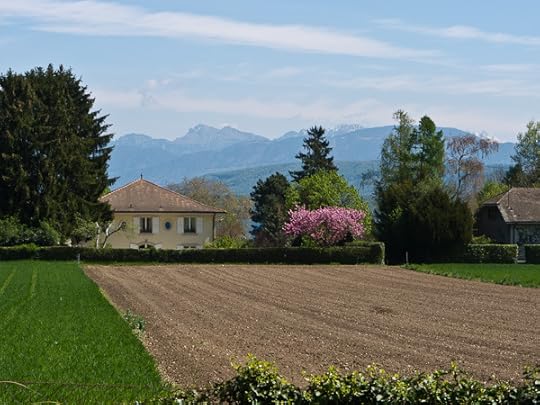
We got together with Sylvia's brother, her nieces, and her step-mother. Lots of warm family visiting,
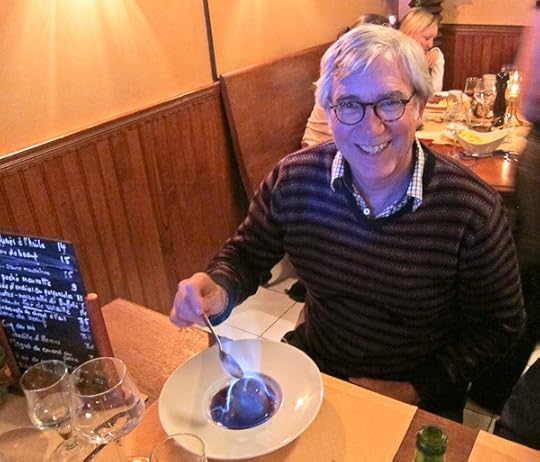
One particular evening Sylvia and I ate in a bistro with four of the young people. It was warm and cozy in there, a magical evening, one of those times that stands forever as a kind of oasis along one's long journey through life. Gus had a horsemeat steak, which is a common thing over there. I had ice-cream flambé. Sylvia's neice Diana told us that when Swiss kids are in bands they sometimes sing a fake English that they call Yogurt—I guess it's a relative of the "French" that the waiters' speak in the Café La Boeuf segments of Prairie Home Companion.
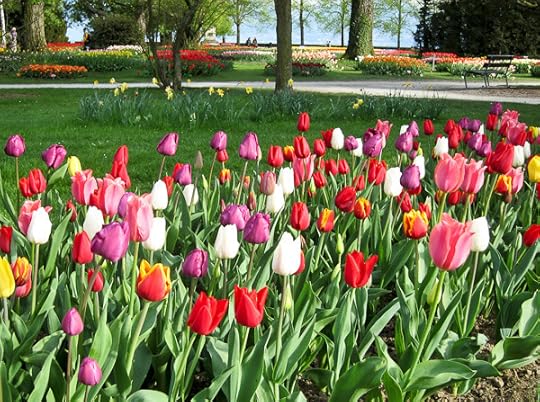
On the last day, we visited Sylvia's step-mother. A sweet woman. She took us to see the the "Tulip Festival" in Morges. It wasn't like a festival in sense of crowds or an admission fee.

It was bed after bed of incredibly gorgeous tulips in a green park at the edge of Lake Geneva, with towering mountains plunging into the lake on the other side.

Hardly anyone there. We wandered in, gorged on beauty, and left.
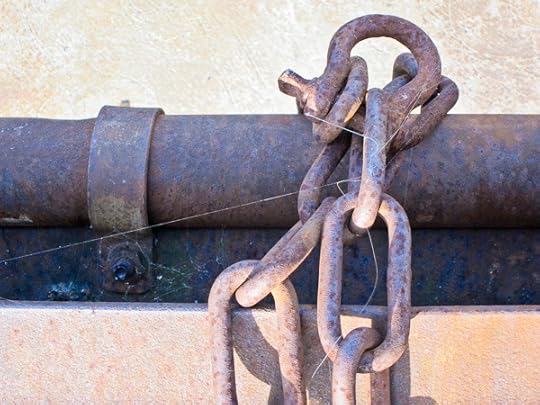
By the time we hit Geneva, Sylvia and I had entered a zone of exponentially increasing physical exhaustion. I was walking slower and slower, like a watch running down. There's something exquisitely pleasurable about being so tired out. I'm very aware of my body, and I deeply savor each moment that I can sit down. The fatigue is like a cushion that I recline upon.
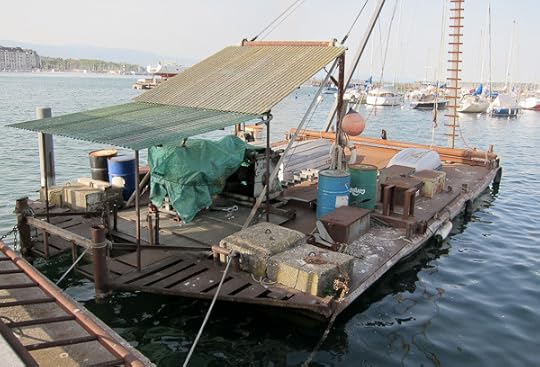
During my afternoon rests and my idle evening hours, I spend hours playing with my photos in my Lightroom program, tweaking my new memories in real time: clarity, contrast, vibrance, exposure, brightness, blacks.

Right next to our hotel I saw a window of high-priced amplifiers which, how retro, include non-digital vacuum tubes. Analog has always been where the truest gnarl is at.

Sylvia and I hit the Museum of Art and History, visiting my two favorite rooms there. In one room are the paintings of Felix Vallotton (1865-1925), a guy with an amazing sense of color. He does mythological kinds of scenes, only the characters are very much recognizable as turn-of-the-century individuals. The paintings are a little bit peculiar…unfortunately I didn't get a shot of any of them.
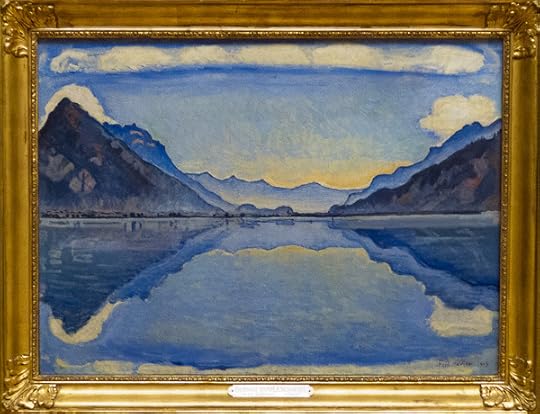
In my other favorite room are works by the Geneva artist, Ferdinand Hodler (1853-1918). He has several styles. In one style he paints amazing scenes of lakes and mountains, quite modern and impressionistic, with really wonderful hues. The paintings take on an abstract, symbolic energy. Hodler has one particular blue that I wish I knew how to mix. The guard told me to take photos, but I snuck one of his "Lac de Thoune" 1909.
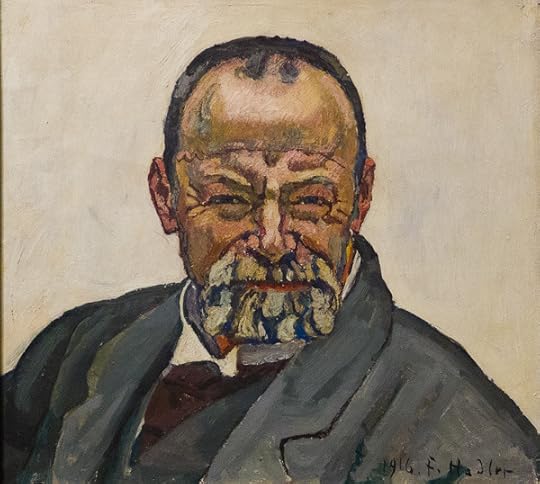
I got photos of three of Hodler's self-portraits as well. These are wonderfully expressive and remarkably differentiated from each other. He's making a face in this one, like a guy in a photobooth. These works speak to me as an aging writer, as Hodler did them in 1916 and 1917, shortly before his death at age 65. What vigor, self-knowledge, irony!
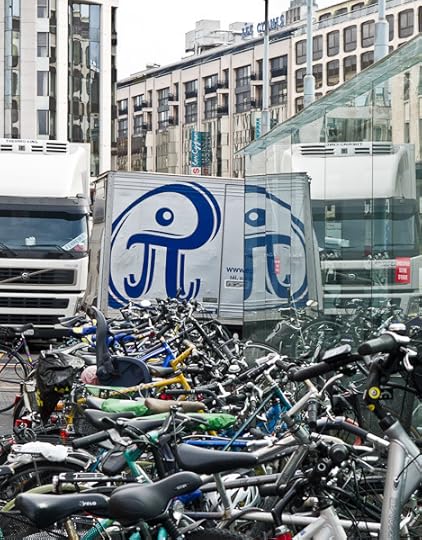
The days of our long vacation roll on, each day with its own little tasks and hurdles. I can imagine being paralyzed with fear and worry—even now, after years of travel, I have tendencies in that direction. But in reality, it's just one step at a time. Walk to the tram stop. Get the tram to the train station. Find the train track. Etc. And if you flub a step—like if you to see a sight and it's closed because it's, whatever, Tuesday afternoon, you can always do something else. If you miss a connection and spend an extra night, you can always find a room.
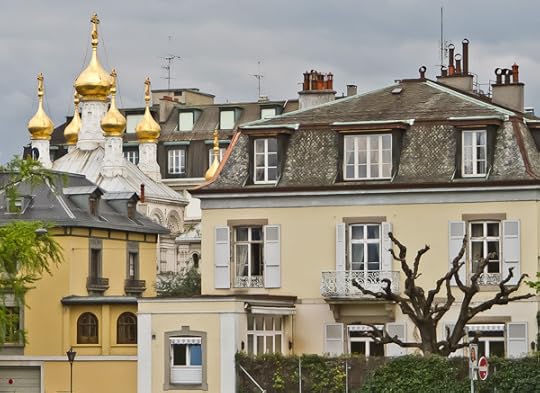
The Swiss public transport is like a clock. The trams, busses, and train cars are of an extravagantly high quality, they roll smoothly, they're frequent and ubiquitous. One aspect of using public transport is that we spend a fair amount of time waiting in public places. I didn't bring my smart phone on this trip. So how to use the time? Look around, duh.
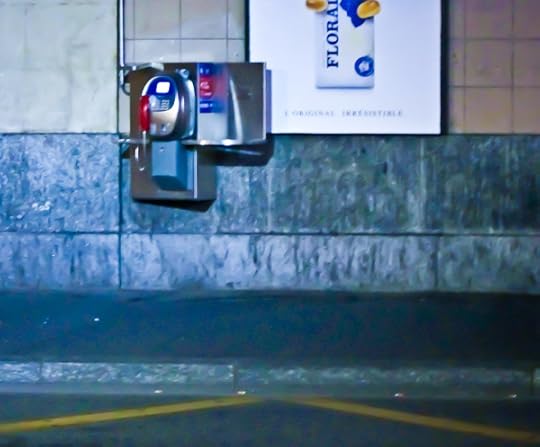
If restless, I pull out the folded square of paper I usually carry in my back pocket and write down what I see, for later incorporation into my travel notes and blog posts. Or I take a photo of a pattern I see in the surroundings.

On the platform in Geneva, waiting for the train to Zurich and on to Munich, I noticed that the people in Europe are thinner than Americans on the whole. No adults wear baseball caps. Almost nobody shaves their head. Leather shoes are more the rule than sport shoes.
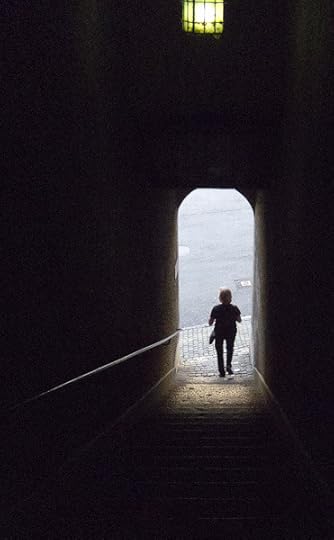
Good to see you again, Geneva. I'll be back.
April 20, 2011
Return to Lisbon, 2011
I was in Lisbon alone for four or five days in 1994, I was in a surrealist movie, Manual of Evasion: LX94, directed by Edgar Pêra and featuring some great Portuguese actors plus me, Terence McKenna, and Robert Anton Wilson. I wrote up my 1994 impressions of the trip in a piece "The Manual of Evasion" that I've put online. (Originally it appeared in the old-school print version of Boing Boing, and in my book of essays, Seek.)
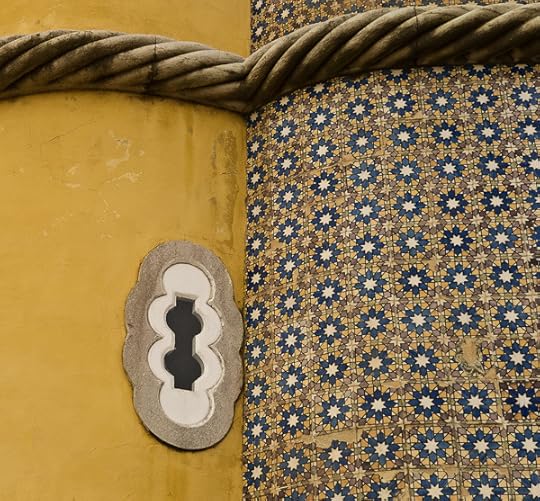
That first trip was a wild, happy time, and I've always had fond memories of it, and had wanted to bring Sylvia to Lisbon so she could experience this city too. Today I'll blog about our trip, and post some of the photos I took, with a few of the photos by Sylvia. I have even more photos that I'll work into future blog posts. You can also see my Lisbon photos (in a largeri resolution) in my Flickr set, "2011, Lisbon."

[Edgar Pêra]
Before setting out, I got in touch with Edgar, and he was still in Lisbon making films, getting plenty of work, and he was happy we were coming.
We got to Lisbon on April 2nd. We stayed at a nice mid-range hotel called the York House, it's a small retrofitted convent in a residential neighborhood about two kilometers east of the main downtown. I picked it for sentimental reasons, remembering how much fun I had when I stayed there in 1994.
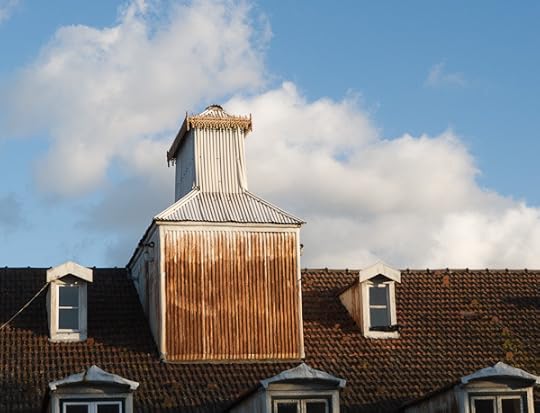
I loved the York House then, and I love it now. We ended up in cozy, quiet modern room with a view of a courtyard with a well and a hill of the city.
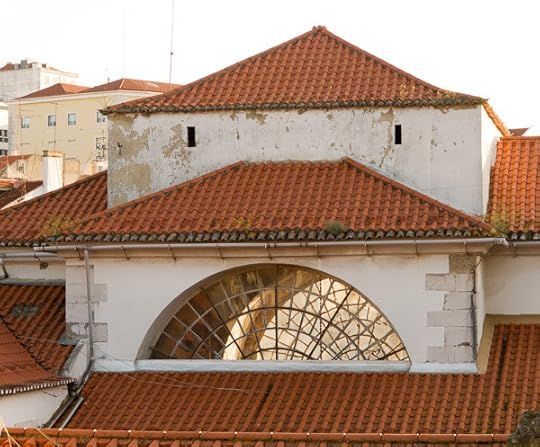
One of the closest buildings looked like a hippopotamus or maybe a monkey to me. Once I started seeing the face, I couldn't "unsee" it, but that was fine. The monkey was my friend, and every morning the sun would light him up. We'd thought we might move to another town during out stay, but the room was pleasant, and moving seemed like too much trouble, so we stayed there eight nights in all.
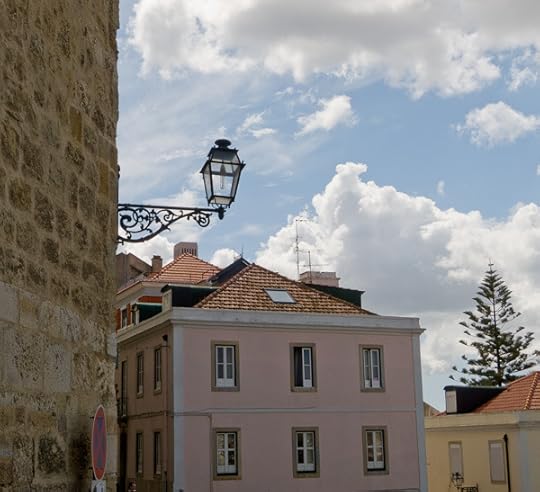
At first I had a little trouble readjusting to Lisbon. It's always difficult—and sometimes disappointing—to revisit the places where you had good times in the past.
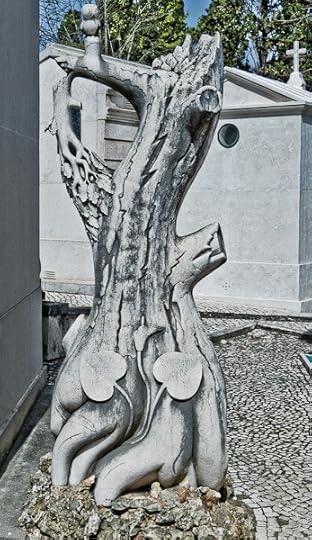
And coming back to Lisbon seventeen years after the last visit—well, Terence McKenna and Robert Anton Wilson are both dead, for one thing. Initially I felt wistfully haunted by their ghosts, and I missed them. Also, in Lisbon 1994, I was high on the local hashish much of the time Even though I've now been clean for many years, I did feel, more than usual, the strain of living life just as it is.
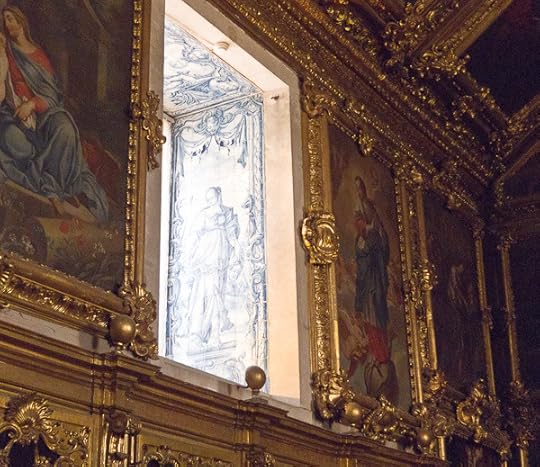
Basically I had to discover Lisbon again, this time with Sylvia along, and without having Edgar ferrying me around from one happening to the next. But after a couple of days we were fully into it.
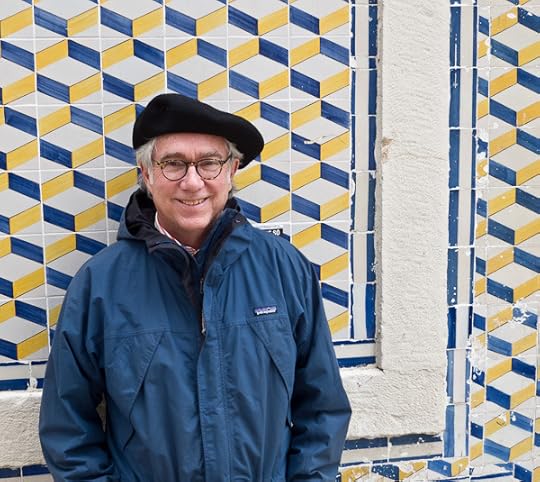
We had a wonderful time looking at Lisbon—touring Lisbon is more about just walking around than it is about seeing individual sights. Some days we'd walk up to a nearby cathedral, Basilica da Estela, which happened to be a place where you can catch a tram into town.
[image error]
Working our way up the long hill, we marveled at how many of the buildings are covered with beautiful tiles, called azulejos in Portuguese. I love the tiles for many reasons. There's a rich mathematical element to tilings, with interesting patterns to contemplate. They come in bright and exciting colors. And, washed by the rain as they are, they're fairly shiny and clean.

The most common tilings are repeating patterns, but some artists assemble large images from sets of unique tiles—murals constructed a bit like jigsaw puzzles, only the puzzle-pieces are squares 14 cm on a side. The 17th Century monastery São Vicente de Fora was filled with Delft-blue tile murals.
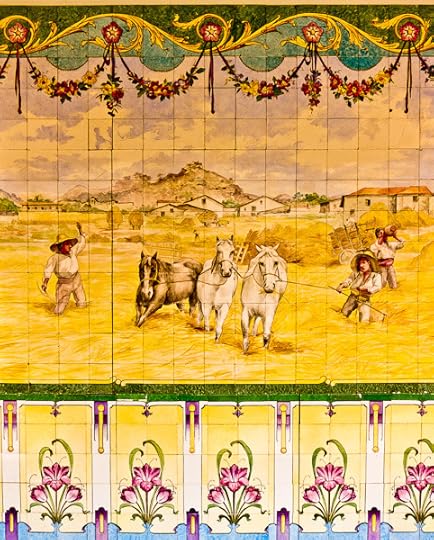
It occurred to me at some point that one of my favorite artists, David Hockney, has used the assembled-grid trick in two different ways—first in creating large images as collages of Polaroid photos, and, more recently, in making mural-sized paintings out of small modular canvases arranged in a columns and rows.
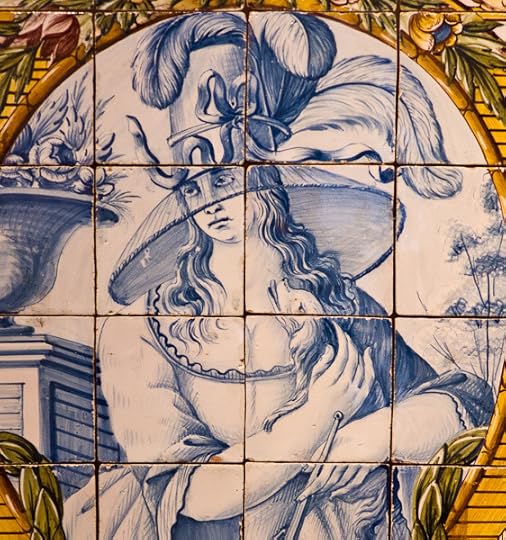
I got so into the tiles that I even visited the Museu Nacional do Azulejo, the Museum of Tiles, a smallish building, a bit out of the way, but with a nice cafeteria. They had some great nineteenth century tile murals.
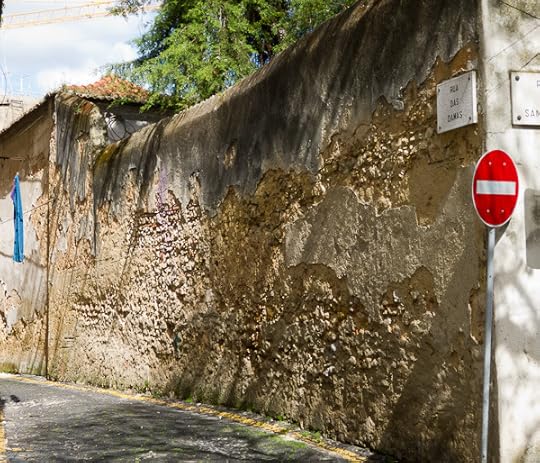
The first day, we hiked up the hill, eating some wonderful and unfamiliar pastries at a pasteleria, saw a wedding at the cathedral, and hopped on the 28 tram, which is by way of being (among tourists) the favorite tram in Lisbon, as it rattles up and down the hills of Lisbon like a slalom rollercoaster, and passes by some of the best-known sights.
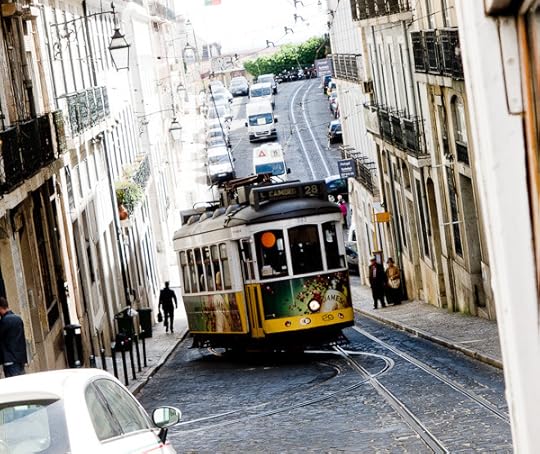
The Lisbon trams are single cars, as in San Francisco, but more streamlined, painted a bright yellow, and a bit shorter than most tram-cars, like minisubs. In spots the tracks are set down in zigzag to slow the pace up and down hills, and on the the tighter turns, the wacky trams swoop across the tracks going in the other direction so as to make the curve.

One of the pleasures of the trams is that the windows open all the way, so that you can ride along fully immersed in the environment.

You're part of the 3D spectacle of Lisboa street-life with hundreds of little scenes playing as you trundle by—not to mention the mini-dramas within the space of the tram itself.

When Sylvia I we were downtown, we usually wandered the zillion quaint narrow streets, drifting down into the old Alfama neighborhood.
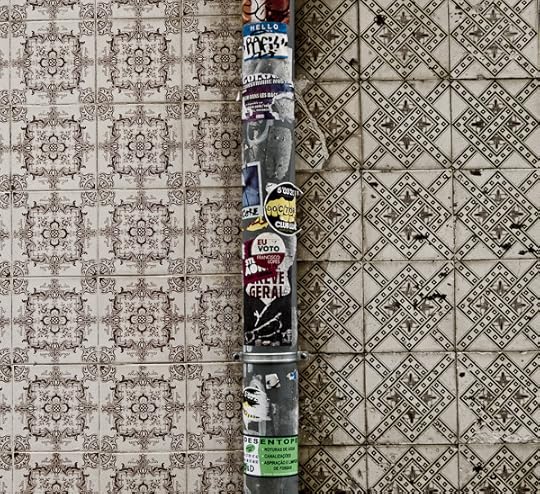
On the hills, with the numerous arches and alleyways, the tiled walls, the staircases, the flapping laundry, and the perspectives above and below, the scenes take on the quality of Escher etchings, with the dimensions looping back on themselves and bending around corners to shake hands.
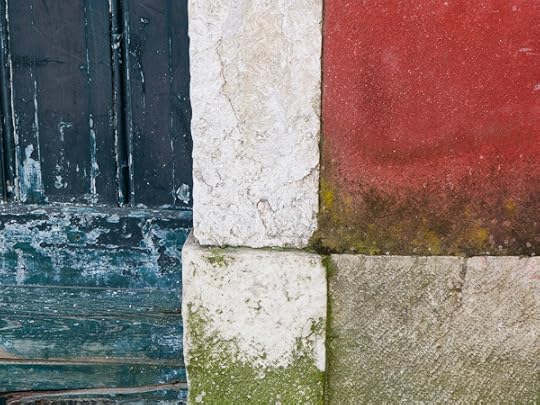
The patches of color fit together into wonderful abstract compositions.
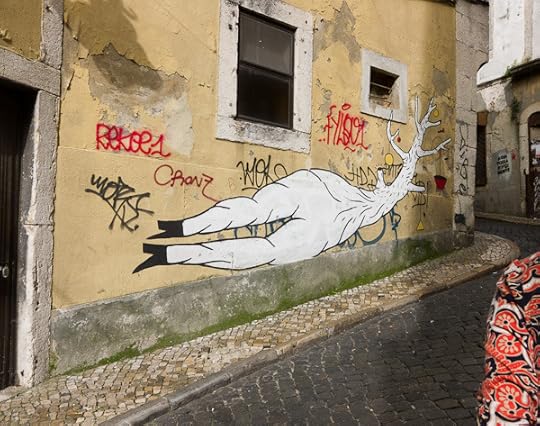
Another notable aspect of the street scenes is the very large amount of graffiti. In addition to the dull, standardized name tags, there's a lot of really large and Mediterranean-feeling splashes of color. There's also some nice stencil work as well.
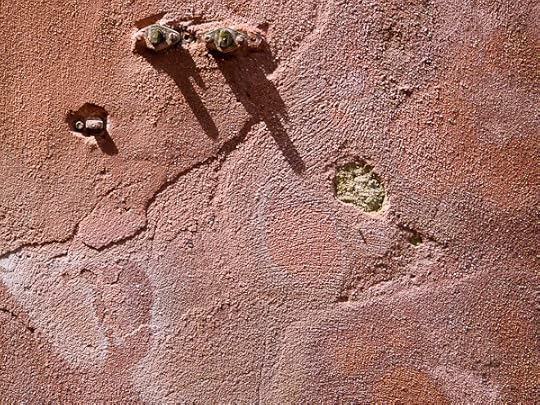
For that matter, even the plaster is interesting.

At one point we managed to connect with a Portuguese writer, Rui Zink, who took us along the street where he was born, in a neighborhood near the Rossio square, a bit livelier than the Alfama.
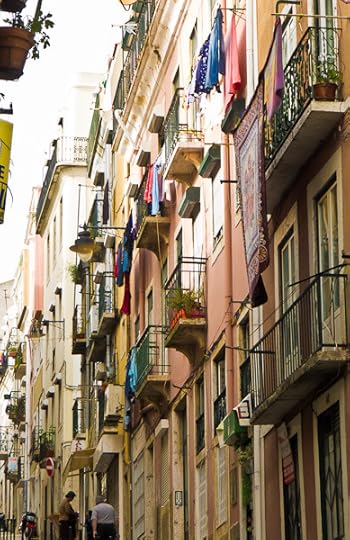
He was proud that the most famous of the Portuguese fado singers, Amalia Rodrigues, had been born in his neighborhood. Like many Portuguese authors, Rui has trouble in getting translated—his only book available in English is a children's book, The Boy Who Did Not Like Television.

Sometimes Sylvia and I would sit in a cafe people-watching, with great characters walking by: intense Portuguese, Euro-hipsters, Africans, old people and people with babies, everyone quite mellow and tolerant with each other.
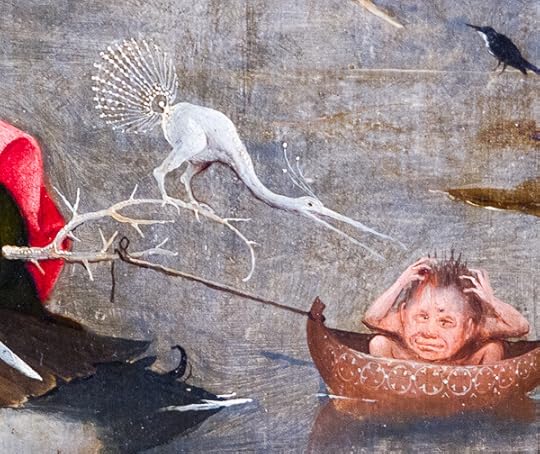
We also got together with my old director, Edgar Pêra. One day he met us at the hotel and escorted us to the art museum down the block, the Museu Nacional de Arte Antigua—it's the biggest art museum in Portugal.
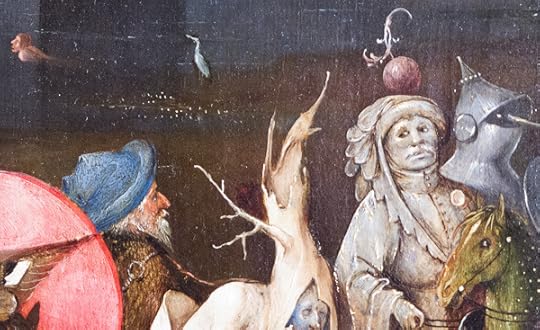
As this was Monday, the museum was closed, but Edgar's production company had gotten permission to film there. He took me to Hieronymus Bosch's Temptation of St. Anthony triptych—where a film-crew of six awaited, with lights set up, ready to film me with the Bosch masterpiece in high-def video. Now that's the kind of welcome I like at a museum!
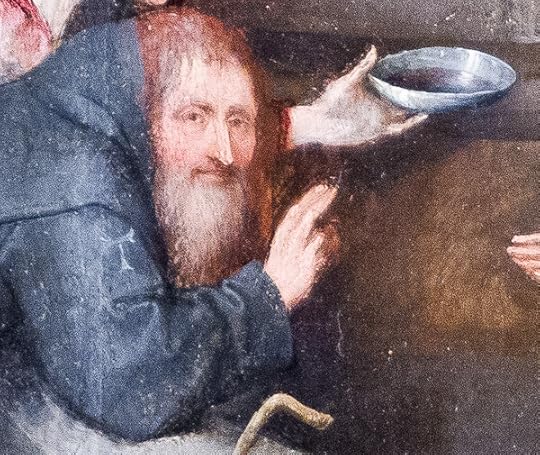
Edgar asked me a few leading questions, and I ended up talking about the painting for about forty-five minutes. The reason we'd set up this shoot is that, a couple of years ago, I thought a lot about this particular Bosch triptych. It appears in my novel Hylozoic, where my main character Jayjay is working as an assistant to Hieronymus Bosch himself, and Bosch is in fact working on the the St. Anthony triptych. I see St. Anthony as Bosch's transreal representation of himself. You can find some of my research notes on Bosch in my Writing Notes for Hylozoic, which is downloadable as a free PDF at my Hylozoic web page.
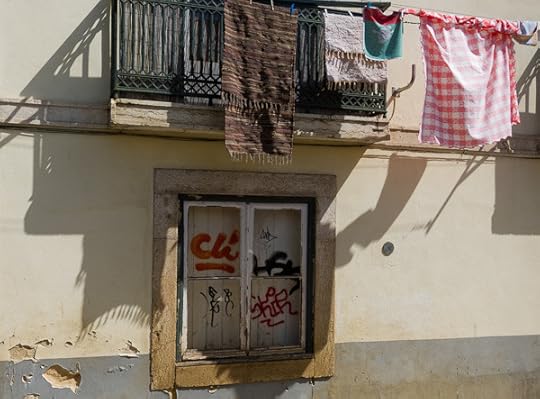
In conversation, both Edgar and Rui Zink were fairly critical of Spain. It's taken considerable determination and individualization for Portugal to stay independent of Spain all these years. Speaking of the Spanish language, a Portuguese might say, for instance, "They use flat, simple, vowels, all the same. That's why they can't learn Portuguese." Note that the Portuguese language has a lot of vowel sounds with a slide in the middle or at the end, also it has many sibilant sounds. It's often remarked that spoken Portuguese sounds a little like Russian.

Sylvia and I had a number of memorable meals—maybe the best was a lunch in a hole in the wall in the Graça neighborhood above Alfama. It was all locals there, very casual, with fresh-caught fish. Near the end of our meal, a guy came by to spray the street.
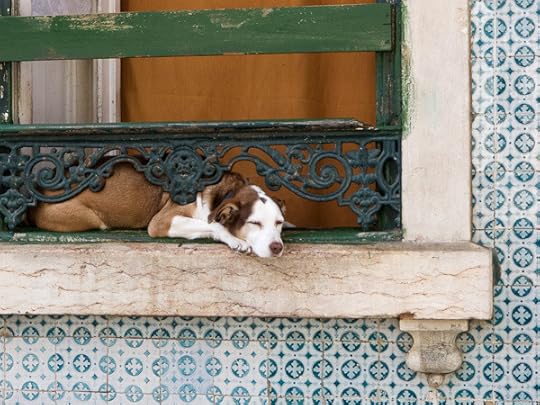
A dog lay sleeping in a window, now and then glancing over at us.
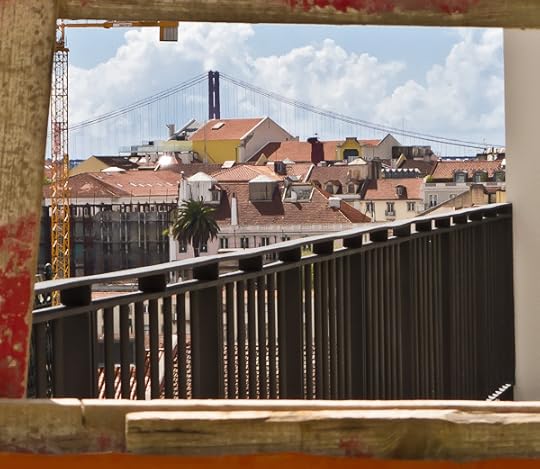
[The bridge across the Teja resembles the San Francisco Golden Gate.]
We had another awesome lunch in a tiny village called Porto Brandão which we reached by riding a cheap ferry from Belem across the Teja river that marks Lisbon's northern edge.
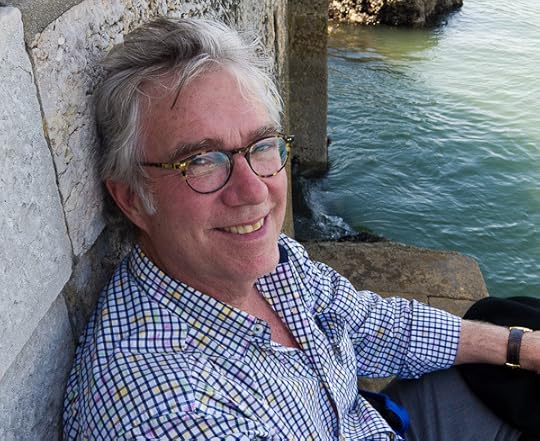
At this place—it's Mare Viva, the big but not imposing restaurant facing the water—we had a lobster stew, unwisely ordering a portion for two, which included the meat four spiny lobsters. The portions in Portugal tend towards the huge.
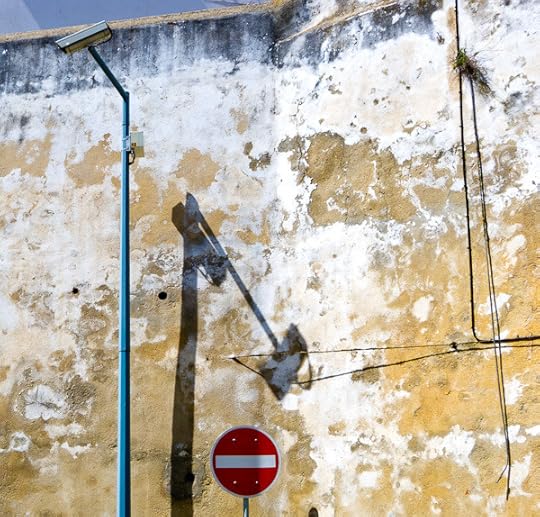
[Dig the space-warped look of that street-lamp shadow. And the wall itself!]
As in Spain, going out to dinner in Portugal takes patience, as you can't really go into a restaurant before 9 pm. If you break down and go at 8, you'll either be completely alone or at the mercy of chatty American tourists. We had a lot of cod, some octopus, sole, olives with everything, and, worth mentioning again, the amazing pastries.
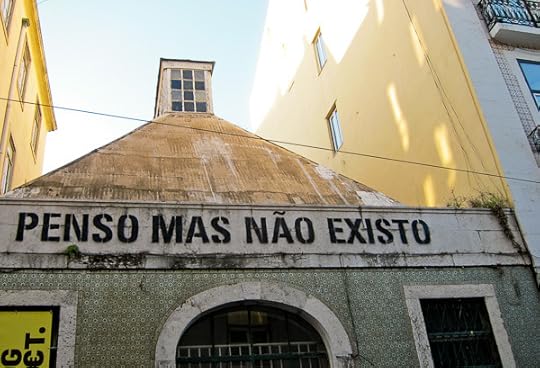
[The sign means "I Think But I Don't Exist". I think.]
The fanciest dinner we had was with Edgar Pêra and his friend Joana Amaral Dias. They drove us to a place on a hill overlook Lisbon and the Castelo de São Jorge. A big celebrity was eating at the next table, the now-retired Portuguese soccer great, Eusebio, who played for the Benfica team.
Joana is a very interesting person, beautiful and witty, a sometime member of the Portuguese parliament, and the author of a best-selling 2010 Portuguese book, Maníacos de Qualidade, (Maniacs of Quality) describing eight odd-ball characters in Portuguese history.

Sylvia were impressed to actually see Joana on TV the next day, debating the merits of the proposed 80 billion Euro bailout of the Portuguese economy by the EU. We had no way of understanding a word, but she had good presentation, speaking intensely, then ending with a smile. I hope some English-language publisher picks up her book.
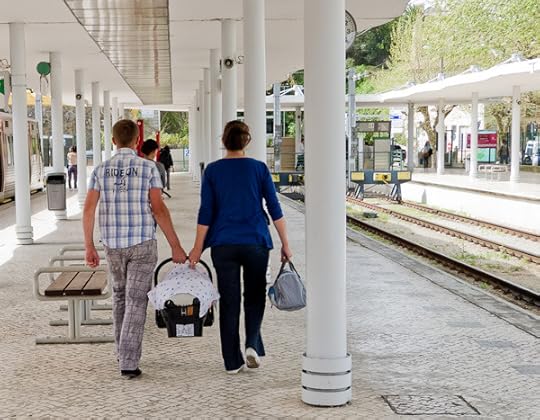
One day Sylvia and I took the train to Sintra, a village about forty minutes from the city center.
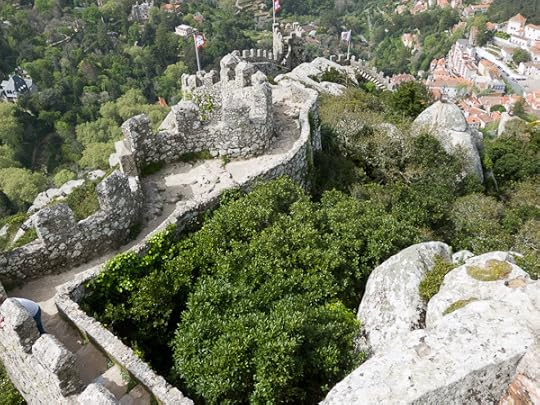
We climbed the insanely long rampart wall of a 9th century Moorish castle. It was a rough trek for us oldsters, with uneven footing, but we made it to the top.
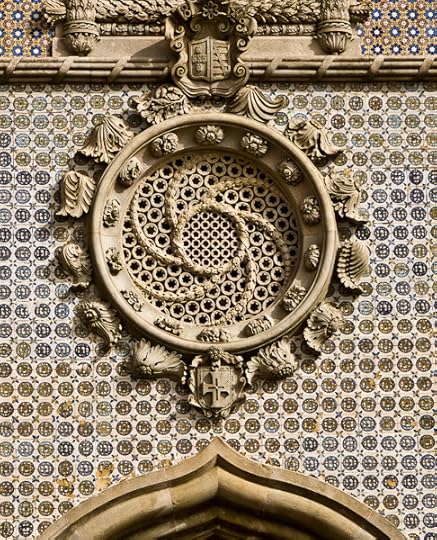
And then we walked around a folly of a Romanticist castle nearby, the Palacio da Pena built on the ruins of a monastery around 1850.

This place was quite hallucinatory.

Another big site we saw was the Monasterio de Jerónimos in Bélem, a few kilometers east of town. This place was built in the early 1500s when Manuel I was riding high off the money the Portuguese were bringing in from Vasco da Gama's newly-discovered route to India. The ceiling in the chapel is just outrageous.
[image error]
As were the arcades.

Some locals were putting on a funny medieval play about people trying to get into heaven, Gil Vincente's "Auto Da Barca Do Inferno."
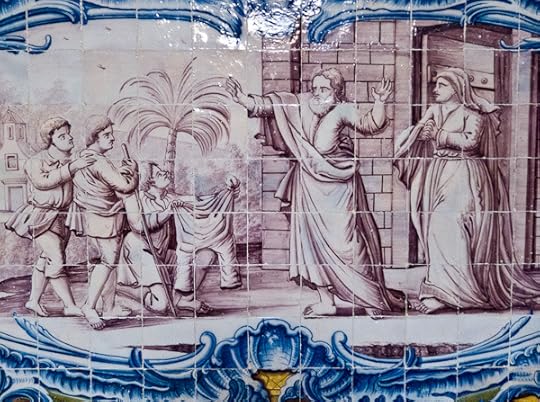
And a tile mural apparently depicts a Bible scene when locals ask Joseph of Egypt why the hell he can't start wearing pants?
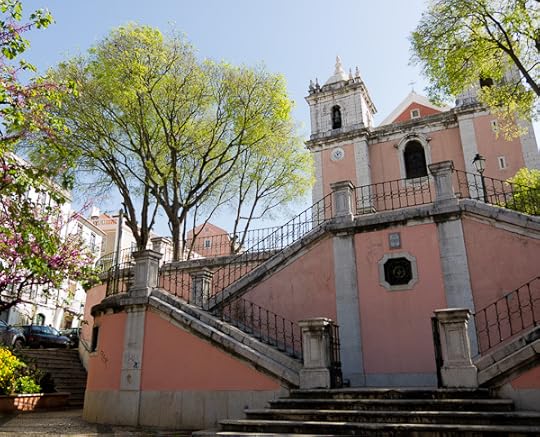
We visited a lot of churches, at least a dozen, maybe twenty, starting with the pink one down the street from the York House. If nothing else, a church is always a shady spot where you can comfortably sit down.
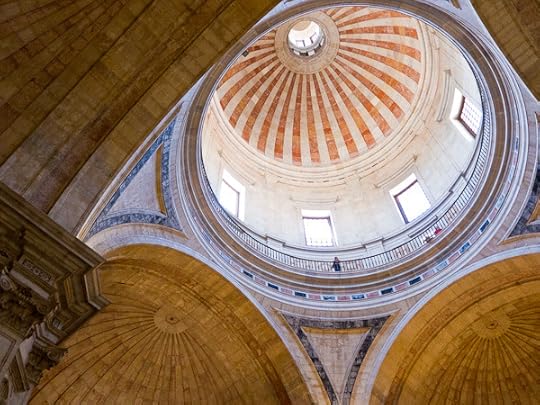
[This dome is in the National Pantheon, not really a church.]
And then you can stare up at the great, high vault, and study the quirky religious art. It's odd how much energy people have put into obsessively depicting the same little constellation of possibly mythical events.
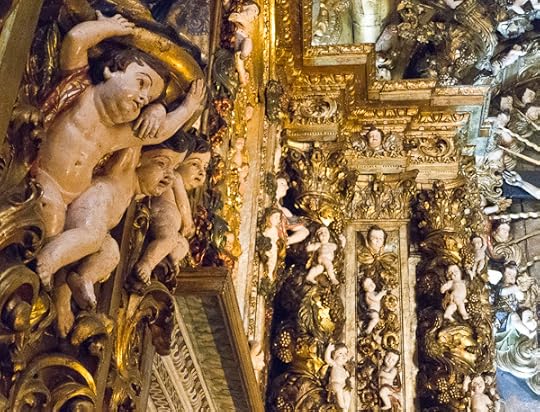
One of the more striking churches was the Igreja de São Roque in Bairro Alto, one of the higher areas that surround the low Baixa downtown. It had side chapels with sculptures and haut-reliefs encrusting their walls and ceilings. Two or three of the chapels were infested with angel babies, teeming, pullulating, like meal worms in flour, like maggots in decaying flesh, like thousand-headed litters of rats. Really kind of disturbing.

And in the center of one of these chapels was a statue of—the Virgin, with a heap of angel-babies accumulating in mounds beneath the hem of her robe. Why don't the call Mary the Mother instead of the Virgin? That would make a lot more sense. Why try and separate the basic reality of sex from reproduction? Christianity is hella strange. But, of course, all religions are. The really weird doctrines serve as hooks that make the faiths stick in your mind.

At one point we saw a funeral go by with a brass band, the horns long-winded and melancholy, in a gorgeous way. They played that funeral march that you hear in old-school cartoons: DAH-DAH-dah-DAAH-DINH-dah-dah-dah-dah-dah-DAAAAH. Across the street, two old ladies in a window prayed over the cortege.

[Genuine "witch broom" spotted in the Cemetery of Pleasures.]
Another day we visited an old graveyard, the Cemitério dos Prazeres, or Cemetery of Pleasure, which struck us as depressing. When we were younger, graveyards seemed funky and fun, but we're realizing that we've reached the point where we'd rather not spend any time in them at all. We'll be there for good soon enough. This said, the place was very scenic, with rows of marble mausoleums amid cypresses, graveyard cats slicking around, and icons of winged hourglasses. "Time flies! What the f*ck am I doing in a graveyard? Outta here."
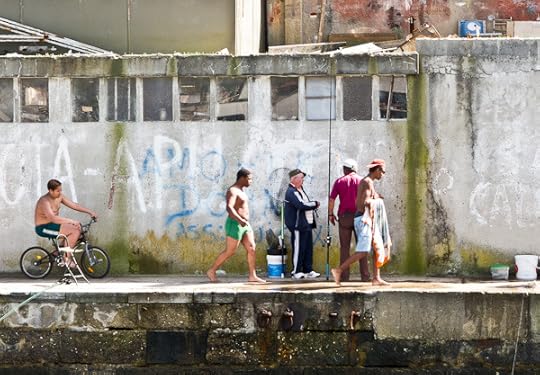
Seeing so many babies and old people, not to mention that wedding and a couple of funerals, and all the tombs in the churches, I started thinking about the wheel of life, and how things change. Walking along I'd sometimes ask myself: Am I deliriously happy? Why not? I'm on a great vacation! But of course my legs were increasingly tired. And I had that slight, nagging desire to get high.
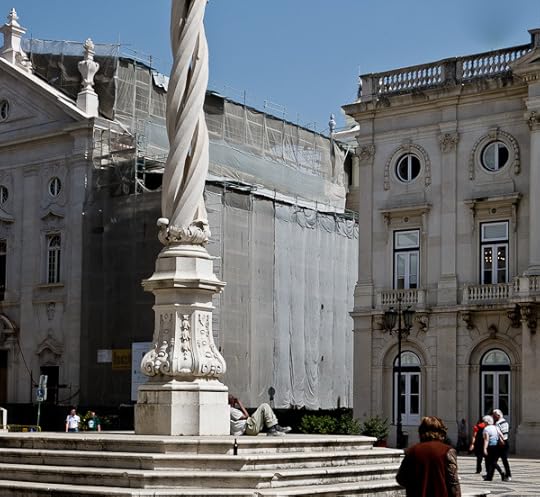
[Statue like a strand of DNA, with bum sleeping at its base.]
Thinking this through having a mug of tea at a place called "pois, café" (pois means "yes") near the Sé (cathedral) one afternoon, I remember that I can in fact be high in the now-moment. Preachy word-mongering or profound truth?
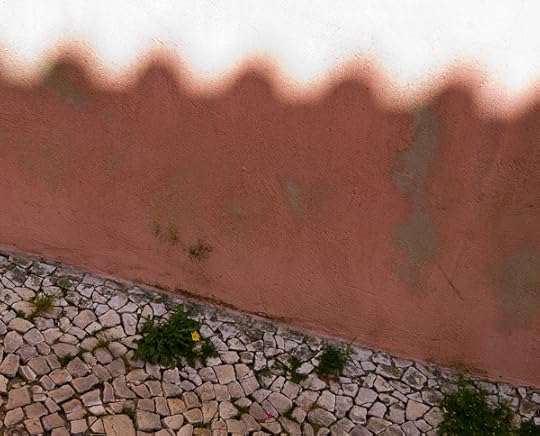
[Shadow of a tile roof on a pink wall, with the ubiquitous cobblestone sidewalk.]
I look at the chairs and tables, just so. The light on their surfaces. The azulejo tile logo on the truck outside, loving the sensory impact of the colors. Tiles on the facing wall across the narrow street. I'm high.
After all, what did getting high really do for me in the old days? It detached me from my worried, got me to see the world as shapes and colors, and put me into the now. But, aha, I can do all of that without taking anything!

I'm relieved at being seated, with every part of my body awake, sweaty, throbbing from my wanderings around town. I take off my shoes and savor the coolness of the rough, ancient stones haphazardly assembled to floor this high-ceilinged room—might have been a workshop or a stable once.
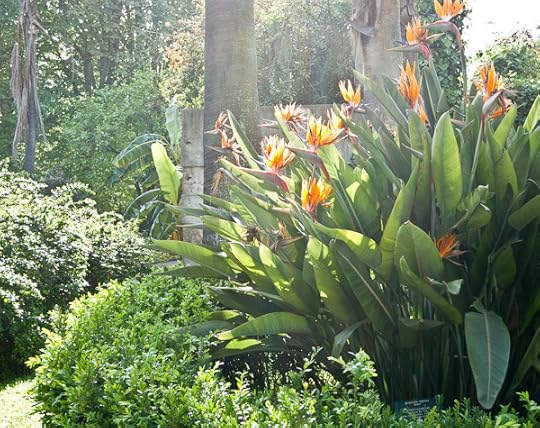
Writing helps me center, helps me be high. And isn't it great to be without a cellphone, off the grid, beyond telephonic intervention, where whatever I'm up to is, like, "It is what it is."
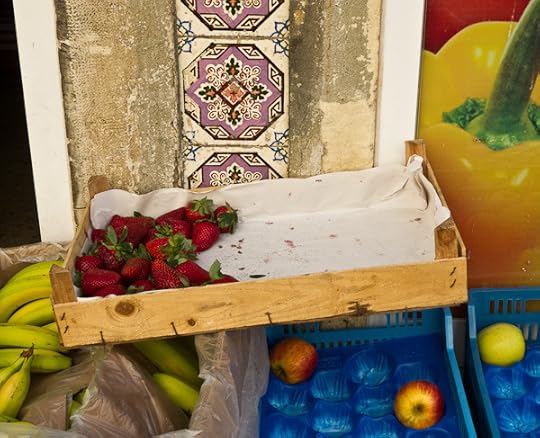
I learned that catch-phrase in 1988 from our then-new friend Faustin from Mill Valley. At first hearing, it struck me as mystically profound, like the first hearing of "All if One," or "Be Here Now," or "Let it come down." It's all about turning off the gerbil-wheel of carking, swinking care. "Put it all down, only go straight."

The next day I was resting on a park bench with Sylvia, wearing my floppy blue wool beret against the intense southern sun, and I took of my shoes again. A woman gave me a look. Oh, oh! I was a Beat Barefoot Bum in a Beret!
Lisbon, 2011
I was in Lisbon alone for four or five days in 1994, I was in a surrealist movie, Manual of Evasion: LX94, directed by Edgar Pêra and featuring some great Portuguese actors plus me, Terence McKenna, and Robert Anton Wilson. I wrote up my 1994 impressions of the trip in a piece "The Manual of Evasion" that I've put online. (Originally it appeared in the old-school print version of Boing Boing, and in my book of essays, Seek.)

That first trip was a wild, happy time, and I've always had fond memories of it, and had wanted to bring Sylvia to Lisbon so she could experience this city too. Today I'll blog about our trip, and post some of the photos I took, although I have even more photos that I'll work into future blog posts. By the way, you can see the whole collection of my Lisbon photos in my Flickr set, "2011, Lisbon."

[Edgar Pêra]
Before setting out, I touch with Edgar, and he was still in Lisbon making films, getting plenty of work, and he was happy we were coming.
We got to Lisbon on April 2nd. We stayed at a nice mid-range hotel called the York House, it's a small retrofitted convent in a residential neighborhood about two kilometers east of the main downtown. I picked it for sentimental reasons, remembering how much fun I had when I stayed there in 1994.

I loved the York House then, and I love it now. We ended up in cozy, quiet modern room with a view of a courtyard with a well and a hill of the city.

One of the closest buildings looked like a hippopotamus or maybe a monkey to me. Once I started seeing the face, I couldn't "unsee" it, but that was fine. The monkey was my friend, and every morning the sun would light him up. We'd thought we might move to another town during out stay, but the room was pleasant, and moving seemed like too much trouble, so we stayed there eight nights in all.

At first I had a little trouble readjusting to Lisbon. It's always difficult—and sometimes disappointing—to revisit the places where you had good times in the past.

And coming back to Lisbon seventeen years after the last visit—well, Terence McKenna and Robert Anton Wilson are both dead, for one thing. Initially I felt wistfully haunted by their ghosts, and I missed them. Also, in Lisbon 1994, I was high on the local hashish much of the time Even though I've now been clean for many years, I did feel, more than usual, the strain of living life just as it is.

Basically I had to discover Lisbon again, this time with Sylvia along, and without having Edgar ferrying me around from one happening to the next. But after a couple of days we were fully into it.

We had a wonderful time looking at Lisbon—touring Lisbon is more about just walking around than it is about seeing individual sights. Some days we'd walk up to a nearby cathedral, Basilica da Estela, which happened to be a place where you can catch a tram into town.
[image error]
Working our way up the long hill, we marveled at how many of the buildings are covered with beautiful tiles, called azulejos in Portuguese. I love the tiles for many reasons. There's a rich mathematical element to tilings, with interesting patterns to contemplate. They come in bright and exciting colors. And, washed by the rain as they are, they're fairly shiny and clean.

The most common tilings are repeating patterns, but some artists assemble large images from sets of unique tiles—murals constructed a bit like jigsaw puzzles, only the puzzle-pieces are squares 14 cm on a side. The 17th Century monastery São Vicente de Fora was filled with Delft-blue tile murals.

It occurred to me at some point that one of my favorite artists, David Hockney, has used the assembled-grid trick in two different ways—first in creating large images as collages of Polaroid photos, and, more recently, in making mural-sized paintings out of small modular canvases arranged in a columns and rows.

I got so into the tiles that I even visited the Museu Nacional do Azulejo, the Museum of Tiles, a smallish building, a bit out of the way, but with a nice cafeteria. They had some great nineteenth century tile murals.

The first day, we hiked up the hill, eating some wonderful and unfamiliar pastries at a pasteleria, saw a wedding at the cathedral, and hopped on the 28 tram, which is by way of being (among tourists) the favorite tram in Lisbon, as it rattles up and down the hills of Lisbon like a slalom rollercoaster, and passes by some of the best-known sights.

The Lisbon trams are single cars, as in San Francisco, but more streamlined, painted a bright yellow, and a bit shorter than most tram-cars, like minisubs. In spots the tracks are set down in zigzag to slow the pace up and down hills, and on the the tighter turns, the wacky trams swoop across the tracks going in the other direction so as to make the curve.

One of the pleasures of the trams is that the windows open all the way, so that you can ride along fully immersed in the environment.

You're part of the 3D spectacle of Lisboa street-life with hundreds of little scenes playing as you trundle by—not to mention the mini-dramas within the space of the tram itself.

When Sylvia I we were downtown, we usually wandered the zillion quaint narrow streets, drifting down into the old Alfama neighborhood.

On the hills, with the numerous arches and alleyways, the tiled walls, the staircases, the flapping laundry, and the perspectives above and below, the scenes take on the quality of Escher etchings, with the dimensions looping back on themselves and bending around corners to shake hands.

The patches of color fit together into wonderful abstract compositions.

Another notable aspect of the street scenes is the very large amount of graffiti. In addition to the dull, standardized name tags, there's a lot of really large and Mediterranean-feeling splashes of color. There's also some nice stencil work as well.

For that matter, even the plaster is interesting.

At one point we managed to connect with a Portuguese writer, Rui Zink, who took us along the street where he was born, in a neighborhood near the Rossio square, a bit livelier than the Alfama.

He was proud that the most famous of the Portuguese fado singers, Amalia Rodrigues, had been born in his neighborhood. Like many Portuguese authors, Rui has trouble in getting translated—his only book available in English is a children's book, The Boy Who Did Not Like Television.

Sometimes Sylvia and I would sit in a cafe people-watching, with great characters walking by: intense Portuguese, Euro-hipsters, Africans, old people and people with babies, everyone quite mellow and tolerant with each other.

We also got together with my old director, Edgar Pêra. One day he met us at the hotel and escorted us to the art museum down the block, the Museu Nacional de Arte Antigua—it's the biggest art museum in Portugal.

As this was Monday, the museum was closed, but Edgar's production company had gotten permission to film there. He took me to Hieronymus Bosch's Temptation of St. Anthony triptych—where a film-crew of six awaited, with lights set up, ready to film me with the Bosch masterpiece in high-def video. Now that's the kind of welcome I like at a museum!

Edgar asked me a few leading questions, and I ended up talking about the painting for about forty-five minutes. The reason we'd set up this shoot is that, a couple of years ago, I thought a lot about this particular Bosch triptych. It appears in my novel Hylozoic, where my main character Jayjay is working as an assistant to Hieronymus Bosch himself, and Bosch is in fact working on the the St. Anthony triptych. I see St. Anthony as Bosch's transreal representation of himself. You can find some of my research notes on Bosch in my Writing Notes for Hylozoic, which is downloadable as a free PDF at my Hylozoic web page.

In conversation, both Edgar and Rui Zink were fairly critical of Spain. It's taken considerable determination and individualization for Portugal to stay independent of Spain all these years. Speaking of the Spanish language, a Portuguese might say, for instance, "They use flat, simple, vowels, all the same. That's why they can't learn Portuguese." Note that the Portuguese language has a lot of vowel sounds with a slide in the middle or at the end, also it has many sibilant sounds. It's often remarked that spoken Portuguese sounds a little like Russian.

Sylvia and I had a number of memorable meals—maybe the best was a lunch in a hole in the wall in the Graça neighborhood above Alfama. It was all locals there, very casual, with fresh-caught fish. Near the end of our meal, a guy came by to spray the street.

A dog lay sleeping in a window, now and then glancing over at us.

[The bridge across the Teja resembles the San Francisco Golden Gate.]
We had another awesome lunch in a tiny village called Porto Brandão which we reached by riding a ferry across the Teja river that marks Lisbon's northern edge.

At this place—it's the big one facing the water—we had a lobster stew, unwisely ordering a portion for two, which included the meat four spiny lobsters. The portions in Portugal tend towards the huge.

[Dig the space-warped look of that street-lamp shadow. And the wall itself!]
As in Spain, going out to dinner in Portugal takes patience, as you can't really go into a restaurant before 9 pm. If you break down and go at 8, you'll either be completely alone or at the mercy of chatty American tourists. We had a lot of cod, some octopus, sole, olives with everything, and, worth mentioning again, the amazing pastries.

[The sign means "I Think But I Don't Exist". I think.]
The fanciest dinner we had was with Edgar Pêra and his friend Joana Amaral Dias. They drove us to a place on a hill overlook Lisbon and the Castelo de São Jorge. Joana is a very interesting person, beautiful and witty, a sometime member of the Portuguese parliament, and the author of a best-selling 2010 Portuguese book, Maníacos de Qualidade, (Quality Maniacs) describing eight odd-ball characters in Portuguese history.

Sylvia were impressed to actually see Joana on TV the next day, debating the merits of the proposed 80 billion Euro bailout of the Portuguese economy by the EU. We had no way of understanding a word, but she had good presentation, speaking intensely, then ending with a smile. I hope some English-language publisher picks up her book.

One day Sylvia and I took the train to Sintra, a village about forty minutes from the city center.

We climbed the insanely long rampart wall of a 9th century Moorish castle. It was a rough trek for us oldsters, with uneven footing, but we made it to the top.

And then we walked around a folly of a Romanticist castle nearby, the Palacio da Pena built on the ruins of a monastery around 1850.

This place was quite hallucinatory.

Another big site we saw was the Monasterio de Jerónimos in Bélem, a few kilometers east of town. This place was built in the early 1500s when Manuel I was riding high off the money the Portuguese were bringing in from Vasco da Gama's newly-discovered route to India. The ceiling in the chapel is just outrageous.
[image error]
As were the arcades.

Some locals were putting on a funny medieval play about people trying to get into heaven.

And a tile mural apparently depicts a Bible scene when locals ask Joseph of Egypt why the hell he can't start wearing pants?

We visited a lot of churches, at least a dozen, maybe twenty, starting with the pink one down the street from the York House. If nothing else, a church is always a shady spot where you can comfortably sit down.

[This dome is in the National Pantheon, not really a church.]
And then you can stare up at the great, high vault, and study the quirky religious art. It's odd how much energy people have put into obsessively depicting the same little constellation of possibly mythical events.

One of the more striking churches was the Igreja de São Roque in Bairro Alto, one of the higher areas that surround the low Baixa downtown. It had side chapels with sculptures and haut-reliefs encrusting their walls and ceilings. Two or three of the chapels were infested with angel babies, teeming, pullulating, like meal worms in flour, like maggots in decaying flesh, like thousand-headed litters of rats. Really kind of disturbing.

And in the center of one of these chapels was a statue of—the Virgin, with a heap of angel-babies accumulating in mounds beneath the hem of her robe. Why don't the call Mary the Mother instead of the Virgin? That would make a lot more sense. Why try and separate the basic reality of sex from reproduction? Christianity is hella strange. But, of course, all religions are. The really weird doctrines serve as hooks that make the faiths stick in your mind.

At one point we saw a funeral go by with a brass band, the horns long-winded and melancholy, in a gorgeous way. They played that funeral march that you hear in old-school cartoons: DAH-DAH-dah-DAAH-DINH-dah-dah-dah-dah-dah-DAAAAH. Across the street, two old ladies in a window prayed over the cortege.

[Genuine "witch broom" spotted in the Cemetery of Pleasures.]
Another day we visited an old graveyard, the Cemitério dos Prazeres, or Cemetery of Pleasure, which struck us as depressing. When we were younger, graveyards seemed funky and fun, but we're realizing that we've reached the point where we'd rather not spend any time in them at all. We'll be there for good soon enough. This said, the place was very scenic, with rows of marble mausoleums amid cypresses, graveyard cats slicking around, and icons of winged hourglasses. "Time flies! What the f*ck am I doing in a graveyard? Outta here."

Seeing so many babies and old people, not to mention that wedding and a couple of funerals, and all the tombs in the churches, I started thinking about the wheel of life, and how things change. Walking along I'd sometimes ask myself: Am I deliriously happy? Why not? I'm on a great vacation! But of course my legs were increasingly tired. And I had that slight, nagging desire to get high.

[Statue like a strand of DNA, with bum sleeping at its base.]
Thinking this through having a mug of tea at a place called "pois, café" (pois means "yes") near the Sé (cathedral) one afternoon, I remember that I can in fact be high in the now-moment. Preachy word-mongering or profound truth?

I look at the chairs and tables, just so. The light on their surfaces. The azulejo tile logo on the truck outside, loving the sensory impact of the colors. Tiles on the facing wall across the narrow street. I'm high.
After all, what did getting high really do for me in the old days? It detached me from my worried, got me to see the world as shapes and colors, and put me into the now. But, aha, I can do all of that without taking anything!

I'm relieved at being seated, with every part of my body awake, sweaty, throbbing from my wanderings around town. I take off my shoes and savor the coolness of the rough, ancient stones haphazardly assembled to floor this high-ceilinged room—might have been a workshop or a stable once.

Writing helps me center, helps me be high. And isn't it great to be without a cellphone, off the grid, beyond telephonic intervention, where whatever I'm up to is, like, "It is what it is."

I learned that catch-phrase in 1988 from our then-new friend Faustin from Mill Valley. At first hearing, it struck me as mystically profound, like the first hearing of "All if One," or "Be Here Now," or "Let it come down." It's all about turning off the gerbil-wheel of carking, swinking care. "Put it all down, only go straight."

The next day I was resting on a park bench with Sylvia, wearing my floppy blue wool beret against the intense southern sun, and I took of my shoes again. A woman gave me a look. Oh, oh! I was a Beat Barefoot Bum in a Beret!
March 27, 2011
Spring Haikus
Sylvia got some of our friends and family to write haikus for my 65th birthday. Here are most of them, along with some random photos from the last few weeks. Cake-cutting photo by Emilio Rojas.
I think I'm going to take most of April off from blogging and tweeting. If you get bored with waiting for new posts, maybe add some haikus of your own as comments here! Any topic is okay, they don't have to be about me or my birthday. Happy spring!
By the way, what is a haiku exactly? Well, there's a precise Japanese formula, but in English it's a little vague. Generally you're talking about a three-line poem with seventeen or so syllables, distributed in a pattern of 5 syllables, 7 syllables, and 5 syllables. But the rules aren't crucial, you can have plus or minus a syllable or two here or there. It's all about the twist, the insight, the zap, the aha.
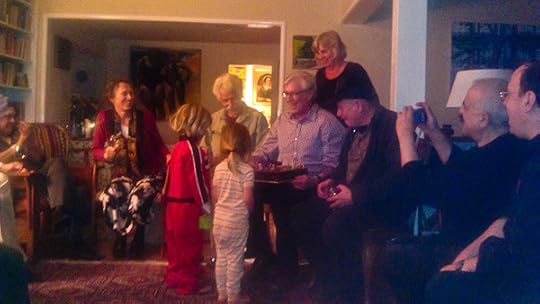
Rudy paints the sea
A giant mutant lobster
Shooting laser beams
—Vernon Head
Hey babe let's go out tonight
Under the full moon
It's raining cherry blossoms
—Sylvia Rucker
on a 4 D trip
o life is a flabber gas
wave on ye old tree
—Georgia Rucker
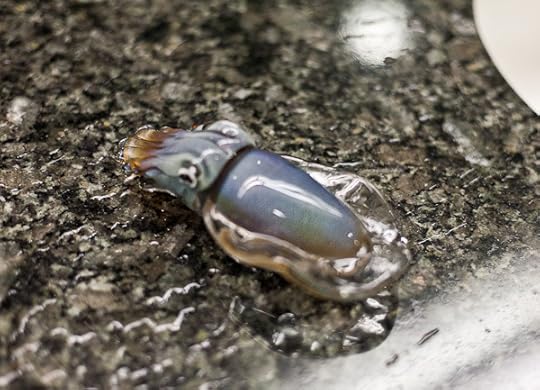
Odd cephalopod
Alien contacts on Earth
Rudy knew it first
—Penny Thomas
We miss Rudy's bash
Many friends brave winter storm
Let them eat cake, yes!
—R.U. Sirius and Eve
chicken chicken chick
chicken chicken chicken chick
chicken chicken hen
—Rudy Rucker, Jr.
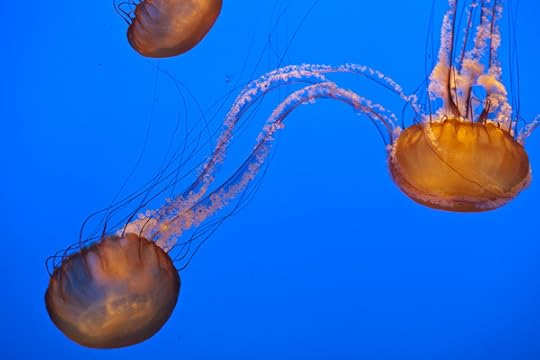
Live long and prosper
Another trip 'round the sun
Spring day, snowy hair
—Nathaniel Hellerstein
O legendary
SF dude, scroll down, log off.
Young pups scratch at door.
—Terry Bisson
He likes to meld (a lot!)
in the Grand Garden of hot
Heliogenic Breath
—Henny Nijland
[image error]
Wielding his brush and pen
the silver-haired patriarch
portrays strange worlds.
—Michael Beeson
The fog lifts. Morning!
Rudy gazes out away,
Twinkling at the door.
—Hilary Gordon
A violin plays
Celebrate, dance and jig
The family circles
—Courtney Lasseter

new piles of spam
turn to a pineapple ham
real life always sweet
—Georgia Rucker
Photographer extraordinaire
To you
Heureux Anniversaire
—Zan Thomas
sixty-five, a number,
nothing more:
and, to be quite clear,
nothing less
—Frank Thomas

Floods, landslides, tsunamis reign
Water abounding
One diamond drop, hovering
—Helen Han
Gnarly nature flows
Gnarly writer wiser grows
Rudy 65, wow!
—Emilio Rojas
Hot damn, it's overflowing
March waterfall
Gnarly and pseudorandom
—Sylvia Rucker
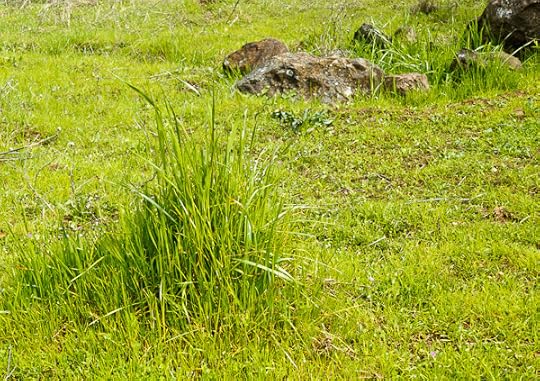
Rudy pleasure birthday
Number of rational
No, number of real!
—Nick Herbert
frogs croak and rumble
rudy rucker ruminating
stochastic flesh is love
—Michael Blumlein
I'm in Mendocino with Nancy on a little vacation.
I'm sorry I couldn't make it to your party.
(Wait, how many syllables is that?)
—Jon Pearce
Rudy Rucker's Blog
- Rudy Rucker's profile
- 583 followers




